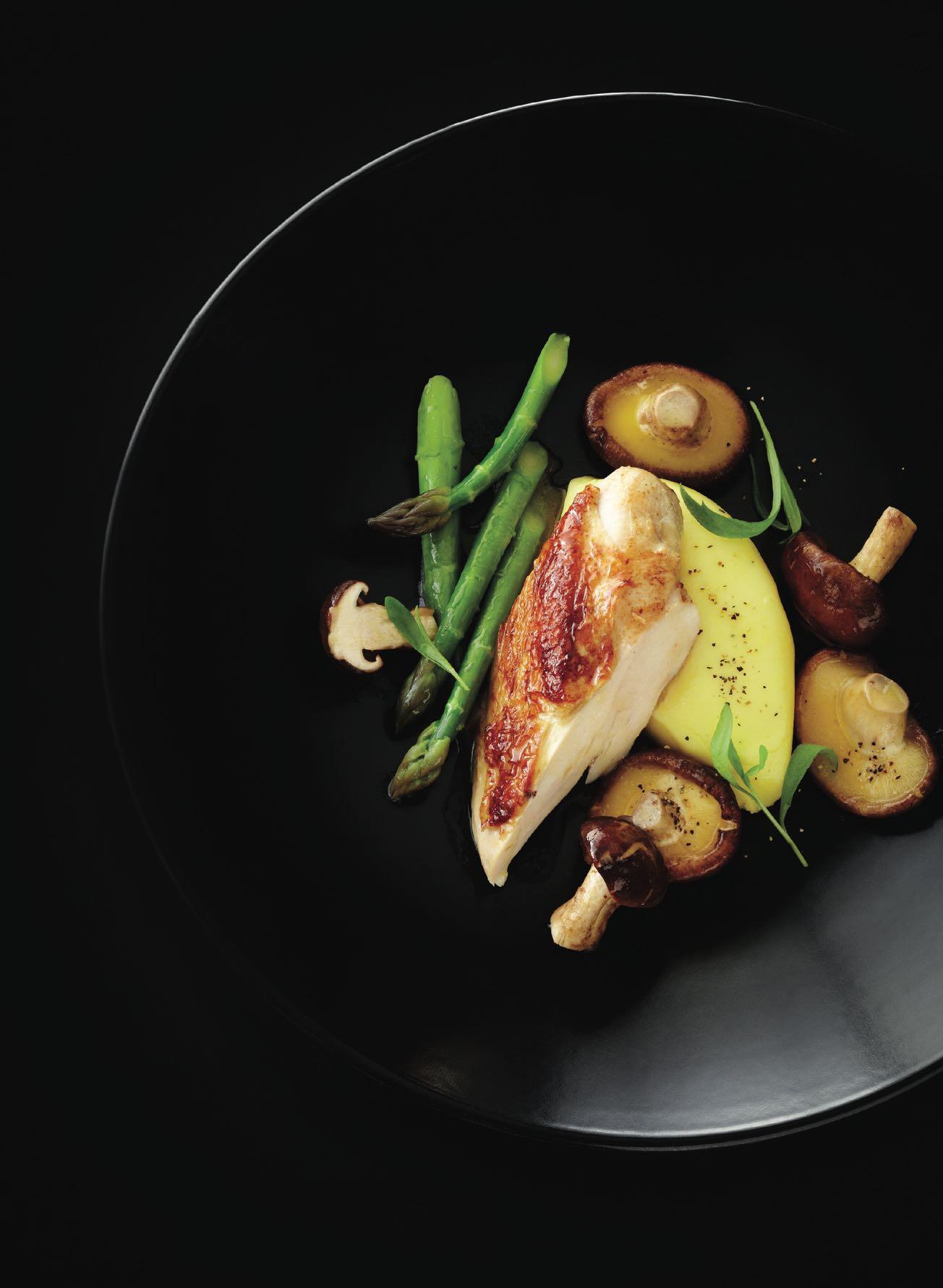



LATEST FOOD AND WINE MATCH UPS Select WHAT’S NEW AT BAROSSA C HEF MARKSOUT H O N The best of wine, food & travel Incorporating WineNZ A LOOK IN AND AROUND ADELAIDE NZD $9.90 $9.90 SPRING 2023










®
BRING ON THE NIGHT

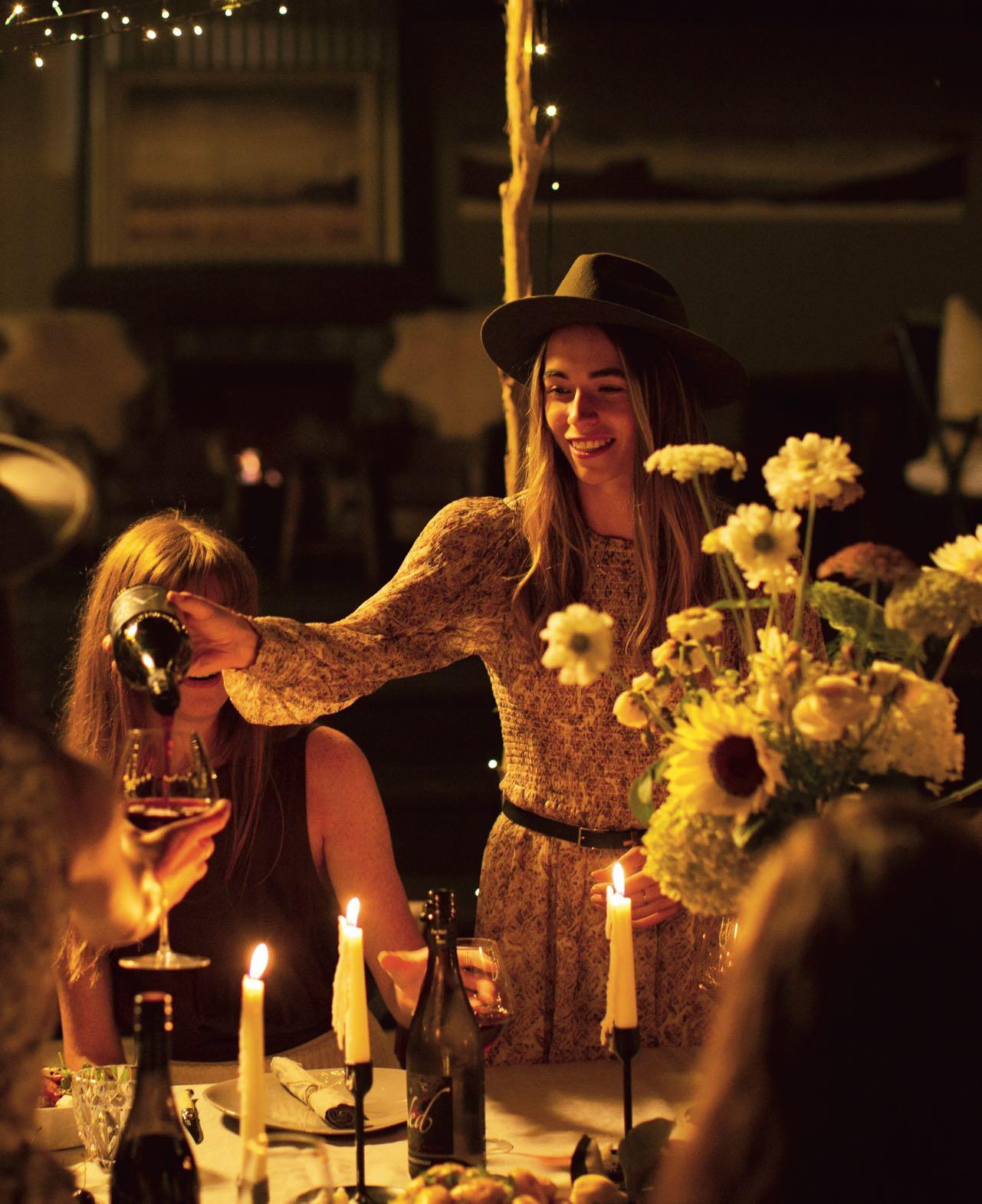
LET GO AND FEEL


CONTRIBUTORS
Martin Gillion, Daniel Honan, Anne-Marie Nansett, Louis Pierard, John Saker, Charmian Smith, Vic Williams.
PHOTOGRAPHY
Courtesy of Winenz.com

Richard Brimer
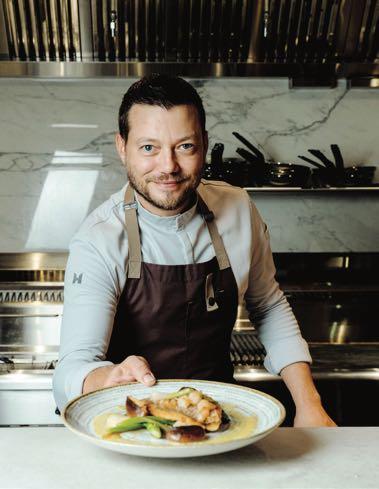
DESIGN
Spinc Media
PUBLISHERS
Colin Gestro 027 256 8014 colin@affinityads.com
Joan Gestro joanlucy47@gmail.com
ADVERTISING ENQUIRIES
Jax Hancock 06 839 1705 jax.affinityads@gmail.com
WEBSITE www.winenzmagazine.co.nz


SUBSCRIPTIONS
i-subscribe.co.nz
Or via 280 retail outlets including all Supermarkets.
Now celebrating over 30,000 readers per issue.
PUBLISHER
www.affinityads.com
Publishers of: Active Seniors, Superbrands, Dive NZ, Select, Seniors and Travel Expo. PO Box 13257 Tauranga 3141
4 | Spring 2023
IN THIS ISSUE
6 19
COVER PHOTO: By Mark Southon
Select
Incorporating WineNZ
58
CONTENTS
6 Mark Southon, Michelin trained chef from London Shows off the best of New Zealand fare. Order his book for recipes to use and enjoy. And watch this space for more from Mark.
14 Start your mouth-watering meal with local Southern Clams from down south. The greatest New Zealand clams and available from most supermarkets. Wine to match each dish.
19 More New Zealand fare. Wonderful New Zealand Beef from fertile greener pastures, Waikato region. What delicious springtime meals with recipes matched with New Zealand wines.

25 Now finish off with New Zealand cheese matched to wine. Good food Group cheese widely available.
28 Wine and time, shows a little of what’s going on- who is winning what and how wineries are progressing out there.
40 A hidden gem for those who love distilled by design. A legendary place to visit, great spirits live here,
44 Toast Martinborough, you must buy tickets and be there. Smallish and unique wine region.

48 Yealands get back to nature.
54 Price of wine versus quality and how it stacks up.
58 The publisher and editor visit South Australia’s wine region. Interesting to visit. Wine a delight to savour and enjoy. Please tell us what you think.

5 www.winenzmagazine.co.nz
44
TASTY TUNA
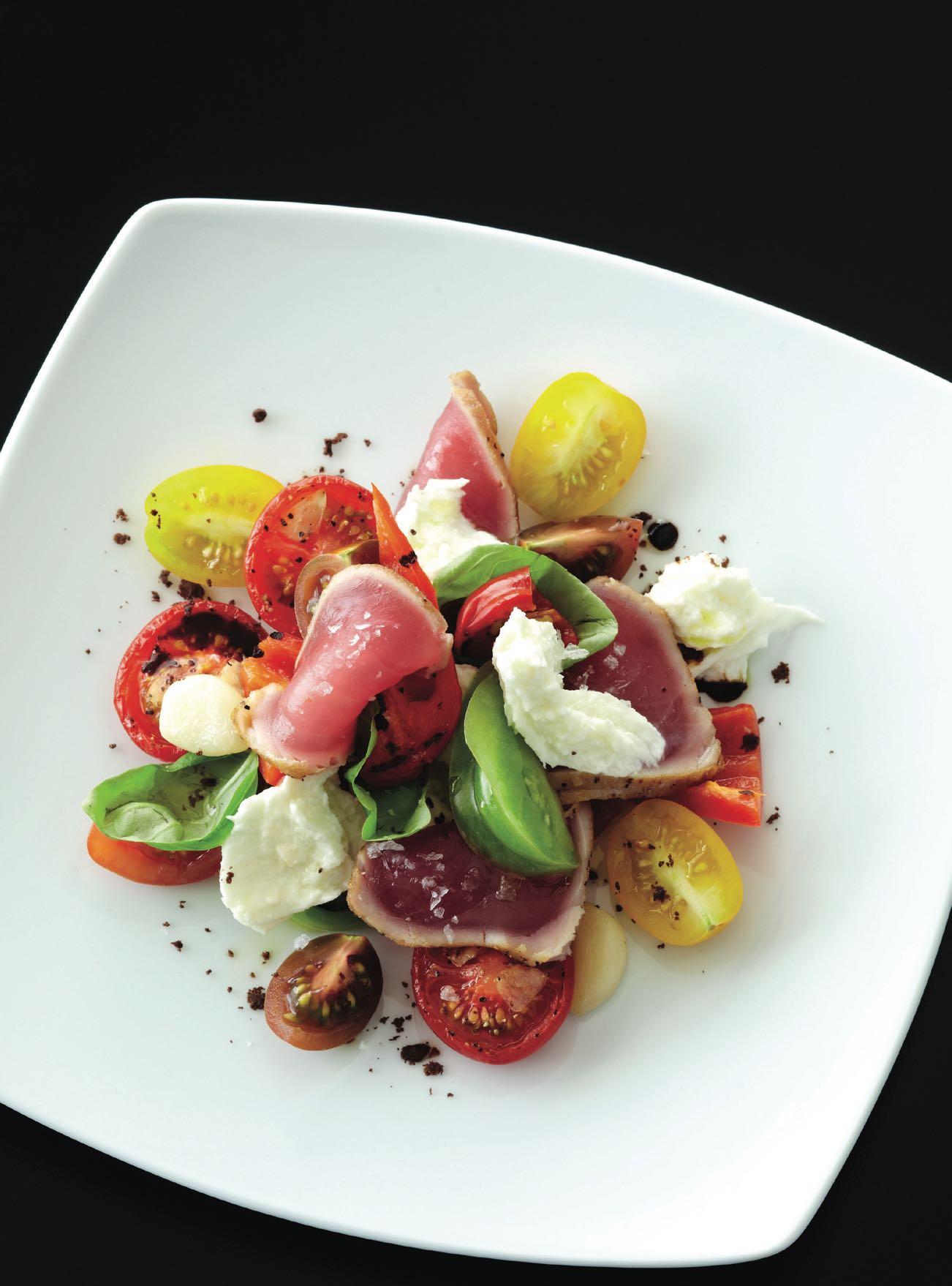
6 | Spring 2023
Food
& Wine Pairing
SEARED TUNA CAPRESE SALAD WITH BUFFALO MOZZARELLA
This is a new take on the classic caprese salad, using the best of local ingredients such as Curious Croppers tomatoes, buffalo mozzarella from Clevedon and dried olive powder from Telegraph Hill in Hawke’s Bay. I’ve added seared tuna to create a heartier dish.
SERVES 4
4 x 150g tuna loin portions oil salt
250g buffalo mozzarella
Black olive powder
Salad
About 1kg selection of tomatoes (preferably Spanish Green, Little Miss Sunshine, Black Morris, Red Kiss, Orange Blossom, White Doris)
Extra virgin olive oil
Flaky sea salt
1 Roast Red Onion 12 Semi-dried Truss
Tomatoes
Confit Garlic Cloves fresh basil leaves
Balsamic Glaze
150ml balsamic vinegar
1 tablespoon sugar
Chef’s Tip

Make this dish at the height of summer when the tomatoes have full flavour and sweetness.
Make the balsamic glaze first so it has time to cool. Add the balsamic to a small saucepan over medium heat and reduce by two-thirds. Add the sugar and continue to cook for 1 minute until it dissolves. Remove from the pan and pour into a small bottle and set aside to cool. The mixture will be thick, but should still flow out of the bottle.
To make the tomato salad, halve and quarter the tomatoes according to size and toss in a bowl with some olive oil and sea salt. Add the roast onion, truss tomatoes, confit garlic and some torn basil leaves. Divide this mixture between serving plates. Heat a frypan on the stove until smoking hot, add a little oil and quickly and evenly sear the tuna on all sides. Remove the tuna from the pan and cut into thin slices. Arrange the slices over the tomatoes and season with a little salt. Tear the mozzarella into bite-size chunks and scatter over the plates, followed by a sprinkle of olive powder, and finally a drizzle of the glaze.
AWATERE RIVER MARLBOROUGH SPINDRIFT ROSE 2023
Vibrant aromatics of jasmine and rosewood. This dry Rose is fine, delicate, juicy and lively on the palate with bright fruit and a long elegant finish.

7 www.winenzmagazine.co.nz
MATCHED WITH
CHEF MARK SOUTHON
BLUE COD

8 | Spring 2023
FOOD & WINE PAIRING
SOUTH ISLAND BLUE COD WITH MUSHROOMS, PEA AND SPRING ONION PURÉE AND MAORI POTATOES
Blue cod is a tasty fish, which mostly comes from the colder South Island waters. It’s much sought after in Auckland and can fetch a pretty price. The earthiness of the artichokes, purple potatoes and mushrooms are a great match for this meaty fish, while the purée provides a refreshing zing.
SERVES 4
4 x 160g blue cod fillets, skin off olive oil
Salt
Lemon juice

200g selection of mushrooms, e.g. shiitake, Swiss browns, oyster, etc, halved
Knob of butter
Sprig of thyme
200g Jerusalem artichokes
200g purple Maori potatoes
20g duck fat
Pea tendrils
Pea and Spring Onion Purée
150g peas (fresh or frozen)
2 spring onions, chopped
50ml olive oil
Salt
Preheat the oven to 180ºC. Heat a little oil in a large non-stick frypan. Pan-fry the cod fillets, skin side down, over a medium–high heat until deep golden brown colour with a nice crust. Turn the fillets and cook on the other side for 1 minute, then finish in the oven for 3–5 minutes or until cooked but still slightly undercooked in the centre. Remove from the oven, season with a little salt and lemon juice and set aside to rest in a warm place for 2 minutes.
To make the purée, blanch the peas in boiling salted water for 1 minute, then refresh in iced water. Strain, then transfer to a blender. Add the spring onion and olive oil. Pulse to create a chunky purée, adding more oil if necessary. Season and set aside until required.
Sauté the mushrooms in a hot frypan for a few minutes until coloured. If using oyster mushrooms, tear into large bits and add them to the pan after the others, as they cook faster. Add the butter and thyme and toss through the mushrooms. Keep warm but do not allow them to become soft.
Wash the artichokes and potatoes, then cut into 5mm slices lengthways. Heat the duck fat in a frypan, then cook the sliced artichoke and potato until coloured on both sides.
To serve, spoon some warmed purée into the centre of each plate and top with a cod fillet. Arrange the mushrooms, artichokes and potatoes around the fish. Finish by scattering a few pea tendrils over each plate.
AWATERE RIVER
MARLBOROUGH CHARDONNAY 2020
Aromas of roasted hazelnut, butterscotch, mandarin, peach and toasty oak. We aim for Chardonnay with class, complexity and texture. This is a rich and rounded wine with layers of flavour, balanced acidity and impressive length.

9 www.winenzmagazine.co.nz
MATCHED WITH
CHEF MARK SOUTHON
FISH + CHIPS

10 | Spring 2023
FOOD & WINE PAIRING
SNAPPER AND CHIPS
Everybody loves good old fish’n’chips. While I mostly only use snapper you can substitute your choice of flaky white fish fillets, e.g. gurnard or tarakihi. Agria potatoes are the best for frying as their lower sugar content means they can stay in the fryer for longer. And cooking the chips three times makes them super-crispy.
SERVES 4
4 x 160g snapper fillets, skinned and boned
Flour for coating
Tempura Batter
Salt
Juice of ½ a lemon
Malt vinegar
Ketchup
Lemon wedges
Tartare Sauce
100g Mayonnaise
¼ red onion, chopped
1 tablespoon chopped flat-leaf parsley
1 tablespoon chopped capers
1 tablespoon chopped gherkins
Salt to taste
Juice of 1 lemon
Thrice-cooked Fat Chips
8 large Agria potatoes
Flaky sea salt
Lemon kelp powder
Chef’s Tip

Make the chips first. Cut the potatoes into big wedges, then slowly cook in simmering salted water until soft. Drain and place them in the fridge to dry. Deep-fry the wedges for 5–6 minutes at 150ºC. Drain and allow to cool. Just before serving, deepfry again, but this time at 180ºC until golden and crispy. Drain, season with salt and lemon kelp powder.
While the potatoes are cooking, make the Tartare Sauce. Combine the mayonnaise with the onion, parsley, capers and gherkins. Use more or less depending on taste. Season with salt and lemon juice.
To cook the fish, lightly dust it with flour, then run each piece through the batter. Deep-fry at 180ºC until golden brown and crispy. Drain on absorbent kitchen paper and season with salt and a little lemon juice. Serve the fish and chips with Tartare Sauce, malt vinegar or ketchup, and lemon wedges on the side.
For an authentic Kiwi fish and chips, I like to serve the snapper and chips in a box made of folded newspaper, like the one in the photograph, and line it with greaseproof paper.
Lemon kelp powder is available in specialist food stores or direct through Great Taste NZ.
AWATERE RIVER MARLBOROUGH METHODE TRADITIONNELLE NV
Aromas of fresh berry with hints of ripe white peach and toasted hazelnuts. The palate is fresh and vibrant with beautiful delicate forest berry characters that linger to an elegant finish.

11 www.winenzmagazine.co.nz
MATCHED WITH
CHEF MARK SOUTHON
Chef Mark Southon has worked in many fine dining restaurants in New Zealand, Australia and the UK. Here he offers a selection of some of his favourite signature dishes that showcase top-quality New Zealand ingredients.


With sections covering everything from seafood and game, to desserts and vegetables Mark’s recipes capture the distinctive qualities and provenance of the produce he uses. His passion for using fare from the wild and ingredients with special characteristics results in a refreshing approach to achieving the utmost flavour from each dish.
This is a book to inspire home cooks to push the boundaries and serve sensational food. A comprehensive “Basics” section provides tips for making all those little extras that make dishes truly delicious. Complemented by stunning photography and useful plating suggestions, Southon Cooking is the perfect kitchen companion to ensure dining is a memorable occasion.
ISBN 978-0-473-41502-0
9 780473 415020
‘Ultimately Southon Cooking is a book about the New Zealand food we love to eat.’

Simon Wright
The French Café
SOUTHON COOKING Mark Southon
Southon Cooking PLC TO PRINT.indd 1
SOUTHON COOKING
Re CI pe S INS p IR ed by f R e SH
Ne W Zeala N d p RO d UC e
Mark Southon
photography by Manja Wachsmuth

10/10/17 7:37 PM
Harvested locally, selected globally
SOUTHERN CLAMS has been harvesting wild populations of Littleneck clams (Austrovenus stutchburyi) in the cold waters of the Otago coast for 35 years and supplies both the domestic market and niche markets in Europe, Asia and North America. The clams are exported live and will reach their destination within 48 hours of harvesting. Southern Clams aims to pioneer environmental responsibility in the clam industry, and has been putting this into practice since being founded by Roger Belton in 1984.
Incorrectly described by Captain Cook as cockles, (due to their similarity to the common European cockle (Cerastoderma edule), the Littleneck Clams belong to the genus Austrovenus, part of the Venus clam family. The name is still colloquially used in New Zealand, although the rest of the world refers to them as clams. They are desired for their use as vongole in European cuisine (particularly Italian and French dishes). Littleneck Clams have the sweet fresh flavour of the sea, and are naturally salty, and the naturally small size of the clams from New Zealand make them excellent for using in pasta dishes.
The clams are harvested in Otago Harbour and Blueskin Bay. The company developed the harvest body-dredge system, where

14 | Spring 2023 FOOD & WINE PAIRING
SOUTHERN CLAMS LTD IS THE SHELLFISH SUPPLIER OF CHOICE IN NEW ZEALAND AND WORLDWIDE
the harvesters pull the metal lattice through the upper-levels of the substrate, harvesting clams which are big enough to take, while letting the juveniles pass through the bars of the dredge. This method of harvesting causes less damage to the shellfish and is gentler on the habitat than a mechanical dredge system.

The clams are sorted at Southern Clams headquarters in Dunedin, where they are hand sorted and chilled in a saltwater bath to between 2-4° and hand sorted, which reduces the clams' metabolic activity, ensuring they arrive at their destination in the best possible condition.
While all harvesting is 'to order', when demand exceeds supply it remains unfilled as the supply level
is set by The Ministry of Fisheries. Southern Clams deliberately adopts a conservative approach to harvesting, as it has sought to increase its knowledge of managing the resource. The company believes that as humans, we all modify our environment. The important thing is to be careful about how we do it.
Vic Williams has been writing and broadcasting about wine and food for more than 40 years.
For three consecutive years Vic joined a panel of international wine and food luminaries including Britain’s Robert Carrier, the USA’s Fred Ferretti, Thailand’s Ken Hom and Australia’s Terry Durack and James Halliday to judge Hong Kong’s best restaurants, and for 15 years he was New Zealand wine consultant for Cathay Pacific Airways. At home, he acted as Cellar Director for the New Zealand Wine Society for the 28 years from its inception until its closure in 2019.
Vic’s contribution to the wine and food scenes in New Zealand has been rewarded with a Lifetime Achievement award from the hospitality industry’s Lewisham Foundation and the Sir George Fistonich medal as a ‘Legend of New Zealand Wine’ from the International Wine Show.
Vic Williams has selected NZ wines to match each southern clam recipe.
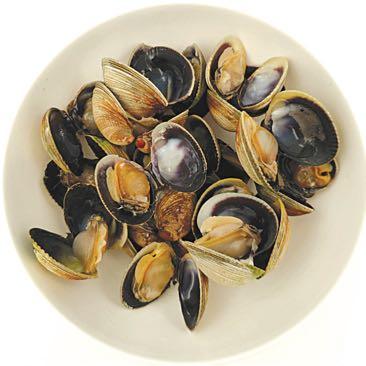
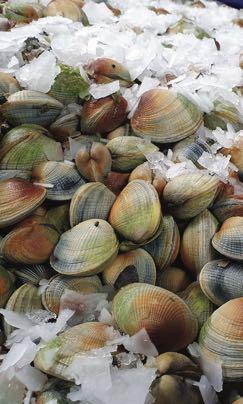

15 www.winenzmagazine.co.nz
Creamy Clam Chowder
SERVES 4
INGREDIENTS
1.5 - 2 kg Southern Clams
1 cup water
100 g bacon, diced
1 Tbsp butter
2 onions, diced
GARNISH:
Paprika, chopped parsley or coriander
4 cups peeled potatoes, diced
Freshly ground black pepper
1 cup cream
3 cups milk
1 Tbsp flour
HUNTER'S OFFSHOOT CHARDONNAY

The 2020 Offshoot Chardonnay shows a layered nose of citrus and apricots, with a hint of nuttiness and pencil shaving oak notes. Stone fruit continues through to the palate where the creamy elegant mouthfeel integrates beautifully with the French oak.
Spaghetti alle vongole
INGREDIENTS
1.5-2kg of Clams
3 Tbsp Olive Oil
120mL White Wine

3 cloves garlic, Thinnly Sliced
500g Spaghetti
1 Sprig Parsley, Roughly Chopped
3 Tsp Butter
1 Red Chili, Diced
Freshly Ground Black Pepper
METHOD
Scrub the clams thoroughly under running water.
Cook the spaghetti according to the directions on the box, but remove from the boiling water one minute less than the recommended cooking time. Reserve 3 tbsp of pasta water.
Heat the olive oil and garlic in the pan, being careful not to burn the garlic.
Add clams and white wine to the pan, covering tightly until the clams just open.
METHOD
Scrub the clams thoroughly and put them in a large saucepan with the water. Cover tightly and steam until the clams open. Strain liquid and make up to 4 cups with water. Remove clams from the shells and chop coarsely.
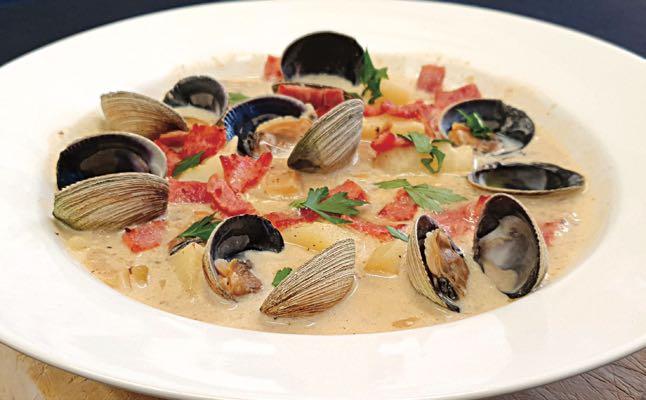
In a large saucepan, sauté bacon in butter until crisp. Remove bacon and keep for a topping. Add onions to saucepan and sauté until transparent. Add flour and cook for a minute or so, stirring constantly. Add diced potato, pepper, and clam liquid. Cover and simmer 15-20 minutes, until potatoes are tender. Purée the potatoes at this stage if you want a smooth chowder rather than a chunky one. Add cream, milk, and clams. Reheat but do not boil. Add more seasoning if necessary. Serve hot, topped with cooked bacon and sprinkled with garnish.
Add the butter, red chili and black pepper to the pan, and stir to combine.
Add the cooked spaghetti to the pan, along with the reserved pasta water, and cook while stirring for around 1 minute. The clams are naturally salty, so shouldn’t need to have salt added.
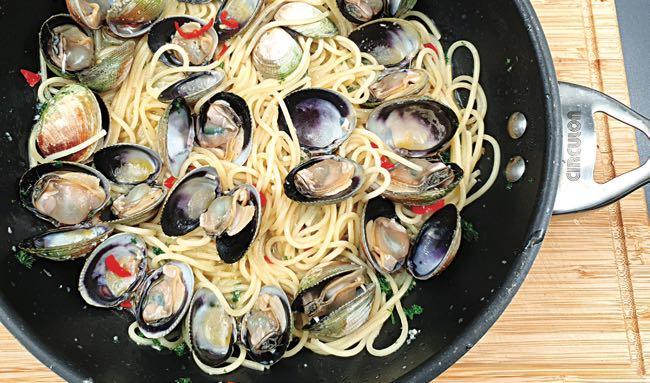
Remove the pan from the heat, and stir through the parsley along with a drizzle of fresh olive oil, and serve immediately.
HUNTER'S KAHO ROA SAUVIGNON BLANC
Continuing with the tradition of fermenting in older oak barrels, the fresh vibrant characters of the Sauvignon Blanc integrate with the French oak beautifully to produce white peach and lime aromas with hints of passionfruit and a grassy edge.
16 | Spring 2023 FOOD & WINE PAIRING
Seaweed, notably wildharvested Wakame (Undaria pinnatifida), is also becoming a developing market for the company. The high quality of our wild-grown seaweed from clean, clear waters also makes it an excellent option for use in pharmaceutical and nutraceutical products.
SUSTAINABLE SHELLFISH

A commitment to harvesting for shellfish in a sustainable way and reducing any environmental impact is part of the central ethos of Southern Clams.
After the clams are machine and hand sorted at our factory, Southern Clams returns any seaweed, empty clam shells and juveniles that have been inadvertently taken back onto the same harvest ground where it was taken from. We believe that this helps to restore the substrate to the way it was before, maintaining ecosystem integrity.
The results from other research shows that clam beds harvested by Southern Clams tend to recover over 50%of their biomass a year after harvest. The impact on other species (macrofauna generally) is almost undetectable after 30 days, as is any effect on the sandy substrate of their habitat. Indeed, evidence shows that reducing the shellfish density by 60% (analogous of thinning carrots) has a positive impact on the growth and health of the remaining shellfish, The clams take 3-5 years to grow to commercial size. The total clam harvest each year is approximately 7% of the clams available within the harvest area, and much less looking at the total biomass available. This evidence suggests that this harvest level maintains a sustainable shellfish fishery.
Southern Clams commitment to sustainability was rewarded by winning the Sustainability and Resilience Business Practice Award at the Otago Business Awards 2020.
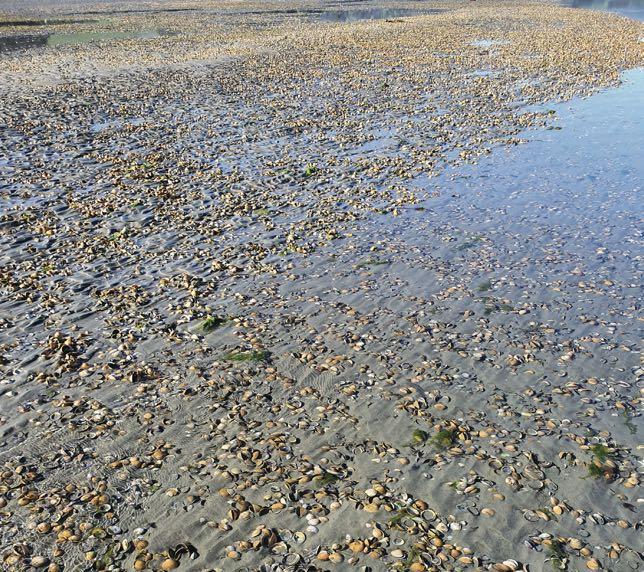
17 www.winenzmagazine.co.nz
Wok Fried Clams
INGREDIENTS
SERVES 4
1.5 - 2 kg Southern Clams
1 scallion, sliced
1 tsp root ginger, grated
125mL water
2 Tbsp Shaoxing Wine
1 small red chili, deseeded and finely sliced
2 cloves garlic, crushed
2 tsp soy sauce
Freshly ground black pepper
METHOD
Scrub the clams thoroughly.
In the wok, add the water, scallion, root ginger and Shaoxing wine and bring to the boil.
Add clams and cook until shells spring open.
Remove clams from the wok.
Add soy sauce, garlic and chili and black pepper to the wok.
Serve clams on a bed of rice, and drizzle with the sauce. Clams being naturally salty, there is no need to add salt.

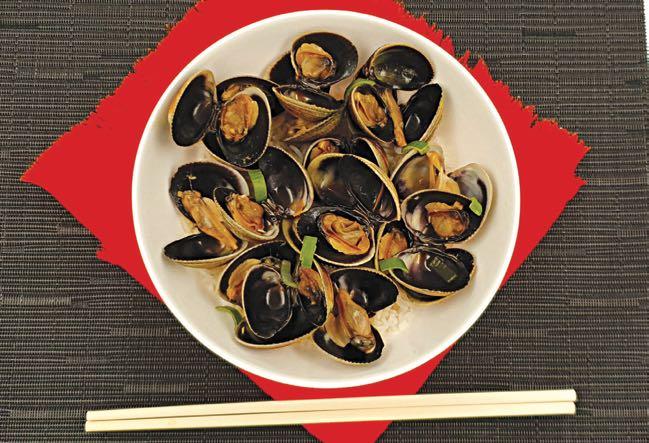
Rustic Clams
INGREDIENTS
1.5-2kg of Clams
1 Medium Onion, Diced
3 Tsp Butter
1 cup Dry White Wine
1 Sprig Parsley, roughly chopped
Dried Italian Herbs
Freshly Ground Black Pepper
METHOD
Scrub the clams thoroughly under running water.
Place the clams in a large saucepan with the white wine, onion, butter, parsley, dried Italian herbs and freshly ground black pepper.
Cover tightly, and steam until clams just open.
Remove from pan immediately so clams do not overcook.
Serve hot, with crusty bread.
HUNTER'S GEWURTRAMINER 2022
The wine has vibrant notes of lychee, ginger and citrus characters on the nose. Fresh pear and apple characters fill the front palate and finishes with some sweet floral characters to balance. The palate has a unique freshness that is due to the free draining soils found at the growing site. Excellent wine that is full of punch and finishes off dry.
HUNTER'S GRUNER VELTLINER 2022
The wine shows flavours of white peach and floral characters on the nose with aromas of stone fruits and citrus undertones. The palate has elegant characters of nectarine and pear with floral notes that extends on the finish. The wine has an upfront palate supported by subtle oak that finishes with a round and lengthy texture. Good example of a well-balanced wine to enjoy now and up to 3 years.


18 | Spring 2023 FOOD & WINE PAIRING
WHETHER for mid-week meals or an impressive dinner party feast, Greenlea Butcher Shop is your partner for providing delicious, export quality, premium beef, lamb and venison. Their products are grass fed, pasture raised, and hormone and antibiotic free. The Greenlea Butcher Shop stocks their own superior Greenlea beef, Ovation lamb, First Light venison, and Restore bone broth. Bring the best to your table with the convenience of online ordering, free delivery, superior customer service and guaranteed quality. Find them at www.greenleabutcher.co.nz and order everything you need for these fabulous recipes. Taste the difference, and you will never go back to supermarket meat!


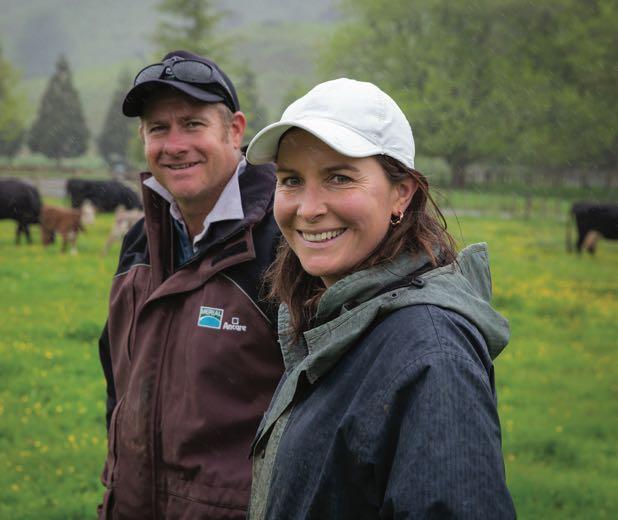




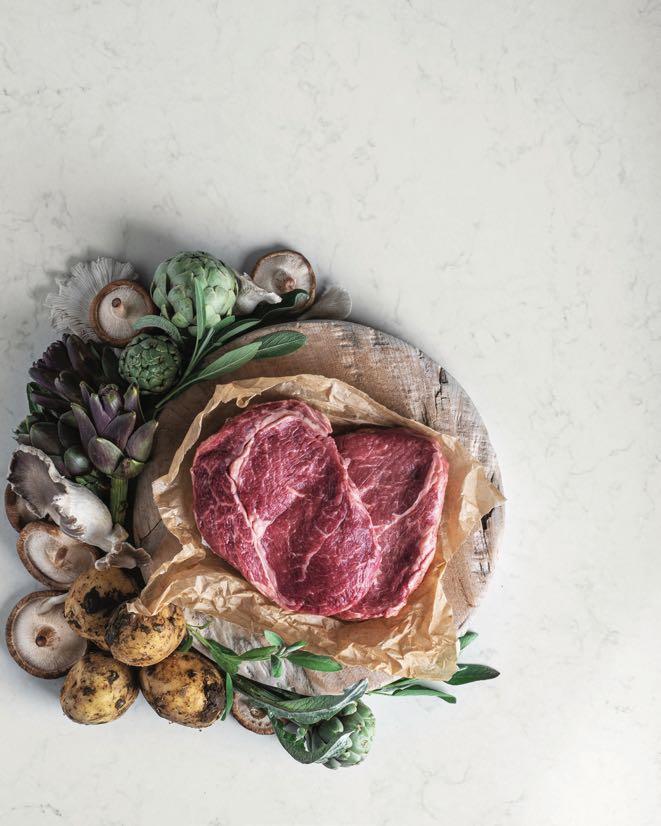
19 www.winenzmagazine.co.nz
INGREDIENTS
Basque Ovation Lamb Shoulder Rack
METHOD
Pre-heat the oven to 150ºC. Thinly slice capsicums, garlic, red onion and chilli.
Cut each lamb rack in half (into double cutlets), season with salt and pepper. In a large heavy-based pan, sear the racks with a little oil, to give colour to the racks. Then remove from the pan.
In the same pan, add olive oil, butter, red onion, chilli, garlic, bay leaves and capsicum. Cook over medium heat, until they begin to soften, then deglaze with wine.
Reduce wine by ¾, then add chopped tomatoes, oregano, vinegar, brown sugar and beef stock or broth. Simmer for 10 minutes.
Add the cutlets to the pan or alternatively, you could transfer to a casserole dish, cover with baking paper and wrap it tightly in tin foil, then place in the oven for 2 ½ hours.
The lamb should be very tender and almost falling from the bone, add in the preserved lemon, drained artichokes, olives and chopped parsley.
Season then serve garnished with crumbled feta, fresh basil and mint leaves.
MATCHED WITH
MAIN DIVIDE
PINOT NOIR 2021

The palate is sweetly fruited and supple with plush polished tannins and a ripe, spice-driven mouth feel.
4 Ovation Lamb Shoulder Racks (2 packs)
2 Red capsicum
2 Yellow capsicum
1 Red onion
1 Red chilli
6 Garlic cloves
2 Bay leaves
1 Preserved lemon (finely diced, zest only)
50 ml extra virgin olive oil
500 ml Beef stock or Restore beef Bone
Broth
100 ml White wine
400 g Chopped tomatoes (canned)
Chef’s Tip
This dish is great for the cooler months and served with couscous or buttery mashed potatoes.
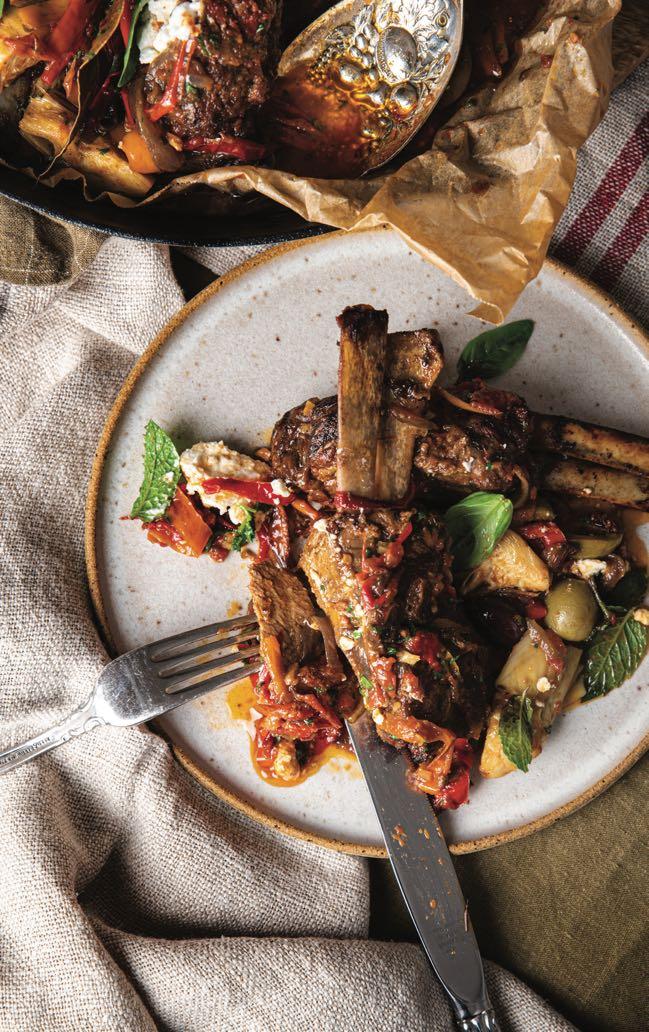
Harmony and length ,flow perfectly through to a long rewarding finish.
30 g Butter
170 g Artichoke hearts (jar)
80 g Green olives (pitted)
80 g Feta
1 tbsp Red wine vinegar
2 tbsp chopped parsley
1 ½ tbsp Brown sugar
1 tsp Oregano (dried)
Salt and pepper
Fresh mint and basil leaves to garnish
20 | Spring 2023
FOOD & WINE PAIRING
Slow Braised Spiced Short Rib of Beef

INGREDIENTS
2.4 kg Greenlea Beef Short Ribs
Sea salt
4 tsp black peppercorns
2 tbsp fennel seeds
2 tbsp cumin seeds
14 star anise
12 cloves
2 cinnamon sticks (broken)
1/2 tsp cayenne pepper
150 g sugar
200 ml red wine vinegar
80 ml tamari or soy sauce
2 tbsp fresh ginger (grated)
6 garlic cloves, crushed
1000 ml Restore Beef Stock
1 red chilli
1 green chilli
1 handful of fresh coriander leaves
SERVES 6 - 8
MATCHED WITH
SQUAWKING MAGPIE GIMBLETT GRAVELS SYRAH

Premium single vineyard grapes from a great vintage have produced a lovely perfumed, dark concentrated wine.
Seamless, with supple tannins.
This Syrah delivers a smooth and spicy finish.
METHOD
Cut the rack into single ribs. Season the beef generously with salt. Seal the short ribs, on all sides, on a hot frying pan or BBQ plate. Once sealed, nestle them into a slow cooker and place to one side.
Heat a large heavy bottomed frying pan on low heat, add all the dry spices and toast gently until fragrant. Remove the spices from the pan and place them to one side.
Pour the sugar into the frying pan and begin to caramelise it, watching closely to ensure it doesn’t burn. When the sugar begins to caramelise in parts, add the red wine vinegar, soy sauce, ginger and garlic. Bring to the boil. When the sugar is dissolved, add back the toasted spices and pour this liquid over the short ribs.
Add the Restore Beef Stock to the cooker and mix well. Cook the beef in the slow cooker for 8 hours on low, or 5-6 hours on high. When the meat is falling from the bone, carefully remove the ribs from the slow cooker and place into a container,
Note: If you don’t have a slow cooker or would like to cook this dish in a shorter space of time, simply use a large cast iron casserole dish with a lid. Preheat the oven to 160ºC and follow the instructions but instead cook for 4 -5 hours. Then proceed with the remaining recipe steps.
cover and chill in the refrigerator, whilst you prepare the sauce.
Strain the cooking liquor through a sieve lined with muslin cloth, into a large saucepan.
Chill the liquid in the fridge until the fat has hardened on the surface. Scrape off the fat and place the liquid on a high heat and reduce by 3/4. It should thicken slightly.
Whilst the sauce is reducing, set out the chilled ribs on a roasting tray lined with baking paper and place under a hot oven grill until sizzling on the top and heated through.
Serve the ribs with the spicy sauce, a scattering of sliced chilli and coriander leaves.
21 www.winenzmagazine.co.nz
Tri-Tip Steak with Italian Potato Salad
METHOD
Remove the steak from the refrigerator and allow it to come to room temperature. Trim any sinew off carefully using a sharp knife. Heat a barbecue with a lid on high until it has reached 250ºC. Season the steak generously with salt and pepper and a little olive oil.
Cook the baby potatoes in boiling water until tender. Cool, add the pesto to the baby potatoes and coat.
Toast the pine nuts gently in a dry frying pan until golden.
Cook the steak on high with the lid down for 6 minutes on each side (55ºC inside) for rare, 7 minutes each side (60ºC inside) for medium rare, 8 minutes each side (60ºC inside) for medium and 9 minutes each side (70ºC + inside) for well done. Allow to rest for at least 15 minutes before serving.
Arrange the rocket leaves around a serving platter, topped with the pesto coated potatoes. Add tri tip steak, thinly sliced against the grain. Finally add parmesan and a sprinkle of pine nuts.


TE MATA CAPE CREST SAVIGNON

BLANC
A bright and pale straw colour with notes of Guava, lime juice ,white nectarine and white peach.
INGREDIENTS
700 g baby potatoes
1/3 cup pesto
1 bag fresh rocket leaves
1/2 cup pine nuts
50 g parmesan cheese, shaved
FROM THE PANTRY:
Salt and Pepper
Drizzle of olive oil
A palate exploding with tropical fruit, salinity and a fine crystalline acidity.
22 | Spring 2023
1 Greenlea Butcher tri-tip steak (approx. 900 g)
MATCHED WITH
FOOD & WINE PAIRING
MATCHED WITH
NO1
FAMILY ESTATE ROSE
Aromas of flowers, cherries and strawberries.
Classic Venison Carpaccio

SERVES 4
To the palate,the wine offers a seamless balance of subtle cherry and almond hints combined with fine acidity. Dry and elegant with fine and silky mousse.
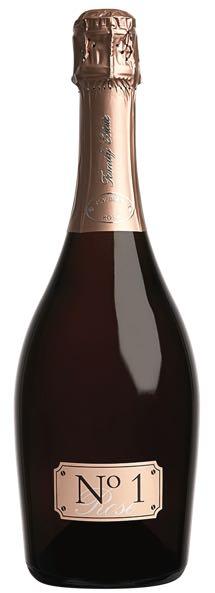
INGREDIENTS
1 First Light Venison Short Loin
1/2 cup parmesan cheese
1/4 cup pine nuts (toasted)
1/4 cup capers
Zest and juice 1 lemon
A couple of handfuls of rocket
1 tsp flaky sea salt
Olive oil
METHOD
Sear the venison in a very hot pan, freeze for 45 minutes and slice thinly. Place each slice between two sheets of baking paper and pound gently with a rolling pin until very thin.
Arrange the slices around your serving plates.
Sprinkle and drizzle the remaining ingredients over the top and serve immediately.
23 www.winenzmagazine.co.nz
Classic French Camembert & Albarino
WHY IT WORKS: The versatile style & sweetness of the Albarino allows the wine to have the ability to adapt to a wide variety of palates, whilst the acidity of the wine cuts through the creaminess of the Classic French Camembert.
ALSO TRY: Full-bodied Grenache.


Food Snob’s Classic French Camembert comes from the picturesque Limousin region in France. This south-central French region takes pride in their gastronomy including authentic soft white moulded cheeses.

Authentic French Camembert’s flavour develops with age, becoming richer and creamier as it matures. A young French Camembert has a milky sweet taste and a firm, crumbly texture. As it matures, the texture becomes smooth & runny, and the cheese has a rich, buttery flavour.
The Classic French Camembert characteristics are creamy, earthy, nutty, fruity, grassy & even mushroomy. These notes pair well with an Albarino which has a complexity of flavours. The Nautilus Albarino has notes of ripe apricot, white blossom & hints of honeydew melon and orange peel which complement the creaminess of the French Camembert. The Albarino has a broad generous palate with a lively freshness that leaves you with a tingling aftertaste.
Food Snob comes from a passion for exceptional food. We love to celebrate with friends & family over good food with delicious authentic cheese & antipasti -


A baked French Camembert is delicious on a charcuterie board or as an hors d’oeuvre. Score the top of the Camembert in a grid-like design, then top with your favourite fruit / nuts / herbs and bake until melty and gooey. We love topping ours with fresh figs, toasted walnuts, and a good drizzle of multifloral honey. The creaminess and earthiness of the Camembert complements the sweetness of the honey and fig. A baked French Camembert pairs deliciously with another wine variety; a full-bodied Grenache which has flavours of dried rose petals, red berries, liquorice and light herbal notes, creating a delicious ensemble with the gooey baked French Camembert
Top tip when serving your Classic French Camembert: make sure to leave the cheese out for about 40 minutes before serving so it’s at room temperature and the cheese will start to ooze on the board!
24 | Spring 2023
ALBARINO 2022 FOOD & WINE PAIRING
NAUTILUS
Danish Creamy Blue & Sauvignon Blanc
WHY IT WORKS: The fresh and fruity notes of the Sauvignon Blanc cut through the sharp & salty blue vein creating a mellow yet flavourful moment on the palate.
ALSO TRY: Riesling.
Also known as Danablu, Denmark’s’ popular Danish Creamy Blue is made using traditional techniques resulting in fine streaks of blue vein in a super soft and creamy cheese triangle wedge.
Food Snob’s Danish Creamy Blue is smooth and satisfying with a mild blue kick. Its extra creamy texture and sharp salty taste requires a fresh and fruity Sauvignon Blanc or dessert wine to balance. The Ara Single Estate Sauvignon Blanc is the perfect match – with citrus aromas including lemon & grapefruit notes. Its luscious, concentrated palate exudes delectable crisp fruit flavours and a vibrant acidity to cut through the mild sharpness of the blue vein.
This Danish Creamy Blue cheese is wonderfully versatile. Serve crumbled on salads or as a dessert cheese with seasonal fruit on a cheese platter or serve alone with beautiful breads or savoury crackers (a nod to the classic Denmark tradition). This cheese is also delicious served with a good drizzle of honey, accompanied by prunes soaked in Port with some thin slices of sourdough bread.

Danish Creamy Blue is the classic dessert course cheese that is simple yet complex in flavours. This cheese is also decadent paired with a dense luscious Riesling - enjoy!
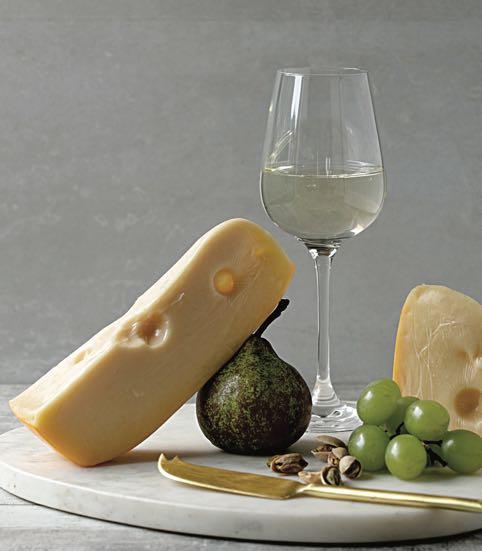
Dutch Maasdam & Chardonnay
WHY IT WORKS: The toasty oak of the Chardonnay meets the nuttiness and buttery-ness of the Maasdam and creates a delightful moment. ALSO TRY: Gewurztraminer.


The Netherlands is renowned for their Dutch Maasdam. Delivering a subtle but smooth and buttery texture with sweetness and nuttiness in a semi-hard cheese. This aromatic cheese is distinguished by its large holes which are naturally occurring from the ripening process.
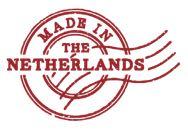
Food Snob’s authentic Dutch Maasdam is perfectly paired with a toasty oak Chardonnay. The Ara Chardonnay has an elegant texture with notes of citrus & stone fruit & hints of toasty hazelnut. These notes pair deliciously with the nuttiness and buttery flavours of an authentic Dutch Maasdam. This lightbodied Chardonnay has fresh, fruity aromas of white & yellow peaches, apple & a touch of quince which complement the mild creaminess of the cheese, bringing out the sweet notes from the cheese.
An authentic Dutch Maasdam is such a versatile cheese that can be used in cooking and on the cheeseboard. Delicious grated into pasta dishes or even better melting into soups or in fondues to add a creamy and nutty flavour to any dish.

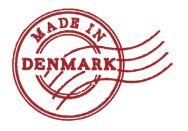
25 www.winenzmagazine.co.nz ARA
CHARDONNAY
PHOTO: BABICHE MARTENS
SINGLE ESTATE
ARA SINGLE ESTATE SAUVIGNON BLANC
Aged English Cheddar & Cabernet Sauvignon
WHY IT WORKS: The smooth, silky tannins of the Cabernet Sauvignon meets the sharp, crumbliness of the Aged English Cheddar – just delightful!

ALSO TRY: Cantera (unique blend of Cabernet Sauvignon, Tempranillo & Cabernet Franc)

Food Snob’s classic Aged English Cheddar comes from a traditional West Country Farmhouse Cheddar maker, idyllically located in the rolling Dorset Downs. The maker’s traditional methods date back many hundreds of years using the highest quality milk sourced locally from their free-range dairy herds that graze the lush pastures of the countryside. This is the secret to their exceptional quality Aged Cheddar.
Food Snob’s Aged English Cheddar is packaged in a distinctive black wax coating or ‘truckle’. This traditional packaging is a simple
method that dates back many years ago that was created to protect the cheese from unwanted mould and from drying out.
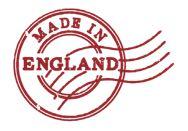
An Aged Cheddar that has matured for up to 12 months has a distinctive sharpness of flavour and firmness to the texture. This cheese variety pairs perfectly with a Cabernet Sauvignon. The d’Arenberg The Coppermine Road McLaren Vale Cabernet Sauvignon exudes opulence with a powerful aroma & smooth, silky tannins. These textures enable the perfect pairing with a sharp, slightly crumbly Aged Cheddar. This Cabernet Sauvignon has distinctive notes of capsicum, savoury spices, blackcurrant & sage. These deep flavours complement the sharpness of the cheese and creaminess of the flavour.
Due to Aged Cheddar’s sharpness of flavour, we love pairing it with sweet, fruity condiments to enhance the flavour profile. Think fig jam, chilli jelly, sweet pickles or honey. Food Snob’s Aged English Cheddar is a great cheeseboard addition or get creative and bake into delicious cheese scones. A great versatile cheese that is perfect for a latenight pairing with your favourite Cabernet Sauvignon in front of a roaring fire.
D’ARENBERG THE COPPERMINE ROAD MCLAREN VALE
26 | Spring 2023
CABERNET SAUVIGNON
FOOD & WINE PAIRING
PHOTO: ALEX MCVINNIE
Danish Havarti & Rosé
WHY IT WORKS: The acidity and mineral finish of the Rosé complements wonderfully with the creamy, buttery-ness of the Havarti.
ALSO TRY: Merlot.
Danish Havarti - Food Snob’s most popular authentic cheese in the range, has origins which present a creamy, buttery flavour. This semi-soft cheese is an excellent table cheese and complements well with a wide variety of condiments and wines.

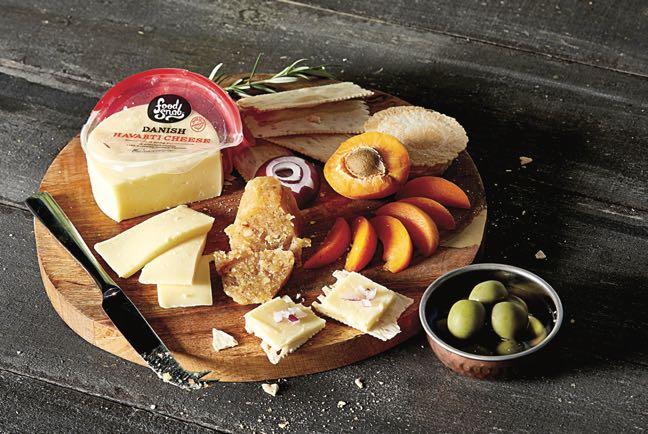
The creamy, buttery flavours of the cheese pairs delectably with a vibrant and earthy Rosé. The Ara Rosé is packed full of alluring red fruit aromas including strawberries & raspberries with hints of ginger & blossom. The Rosé’s acidity and mineral finish creates a lipsmacking vibrant drink that pairs delightfully with the creaminess of
French Truffle Brie & Pinot Noir

the Danish Havarti, cutting through the buttery-ness.
Food Snob’s Danish Havarti is a staple and every so versatile! The creamy and buttery texture of the cheese makes it the melting cheese of choice. Delicious for fondue or addictive in a toasted sour dough sandwich with Jenny’s Kitchen Tamarind Chutney – you won’t regret it! Certainly, one of the most loved cheeses from Food Snob due to its premium authentic Danish quality.
ARA SINGLE ESTATE ROSÉ

Only France can deliver an authentic, moreish French Brie with a decadent layer of summer white truffle. Two layers of creamy French Brie encompasses a rich layer of white truffle through the centre of the Brie wheel. The even layer of white truffle ensures each slice of French Truffle Brie carries the perfect amount of delectable truffle flavour.
Food Snob’s French Truffle Brie pairs deliciously with a deep, rich Pinot Noir

aromas of the cheese. This Marlborough Pinot Noir showcases the area's elegance, integrity and balance and the deep, rich fruity notes, chalky tannins and silky textures of the wine ensure the French Truffle Brie flavours flourish when paired together.
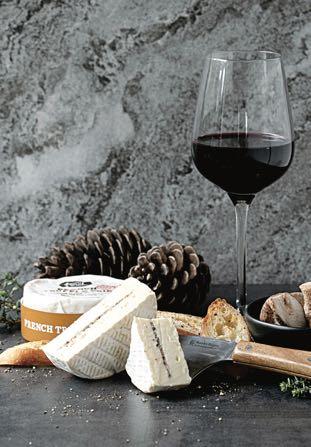
WHY IT WORKS:The deeply fruity notes & silky textures of the Pinot Noir makes the white truffle and silkiness of the Truffle Brie sing.
ALSO TRY: Barolo.
The Ara Pinot Noir is the ultimate match for this heavenly decadent French cheese. The expressive notes of cherry, boysenberry & a hint of cinnamon complement the intense truffle
French Truffle Brie is absolutely delicious simply spread on salted crusty crostini bread as it allows for the white truffle flavours to shine. To take things to a more decadent level, the French Truffle Brie can be baked, turning into an oozy, gooey cheese – delicious for dipping bread sticks in. This authentic cheese is also wonderful melted into pasta dishes for the ultimate trending truffle pasta.
Top tip when serving your French Truffle Brie: make sure to leave the cheese out for about 40 minutes before serving so it’s at room temperature and the cheese will start to ooze on the board!
ARA SINGLE ESTATE PINOT NOIR

27 www.winenzmagazine.co.nz
PHOTO: BABICHE MARTENS
CENTRAL OTAGO ‘TERROIR’ COULD HELP ADDRESS GLOBAL SHORTAGE OF PREMIUM WINE - FRENCH WINEMAKER
GROWING conditions and soil quality in Bannockburn, a 350 hectare area of Central Otago, have been identified by a French winemaker as uniquely positioned to help address a global shortage of super-premium wine.
Baroness Ariane de Rothschild, CEO of Edmond de Rothschild Group, who is in New Zealand to oversee the establishment of the company’s first organic wine production facility, Akarua, says they also want to learn from and work collaboratively with other winemakers in the region to
raise the international profile of Bannockburn.
Madame de Rothschild says while they were first attracted to Central Otago for its exceptional terroir, there is growing recognition that the region has a key role to play in helping to meet global demand in the premium wine segment.
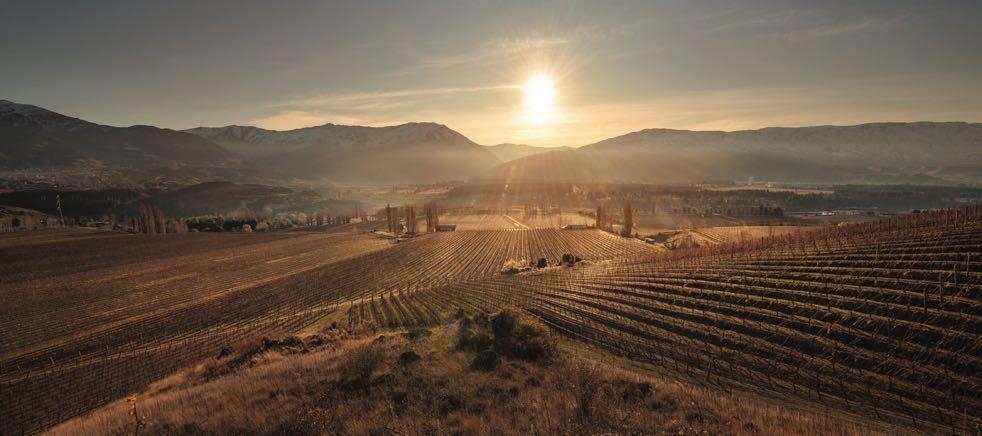
“We know the global market for Pinot Noir is growing rapidly and Akarua is a key strategic vineyard for Edmond de Rothschild Heritage to expand this part of our collection.
NZ TO HOST NEW 2024 INTERNATIONAL WINE TRADE EVENT IN BLENHEIM
BLENHEIM, New Zealand — Get ready to experience the latest and greatest in the wine industry with the highly anticipated New Zealand WinePRO trade event! This new trade event will be held in Marlborough, the biggest wine production region in New Zealand, from 25 to 27 June, 2024.
With the tagline ‘Vine to Wine’, WinePRO will showcase the latest products, new technology, and connect the leading suppliers with members of the wine production industry. This event will provide an opportunity for the wine industry to come together and learn about
the latest trends, network with each other, and discover new ways to grow their businesses and improve efficiencies and production, with an exhibition showcasing the latest and greatest. The event has been a vision of the Marlborough District Council and Wine Marlborough, recognising the importance of wine to not only the region but nationally - and the need to have a biennial event to bring the industry together across New Zealand and the world. The venue will be at Stadium 2000, combining indoor and outdoor display spaces and featuring an
“Working with other growers in the region as a collective we can develop the international reputation of Bannockburn more effectively.
“Our existing distribution channels in 80 countries include some of New Zealand’s non-core wine markets such as Japan, South Korea, France, Switzerland, South Africa, Argentina and United Arab Emirates provide us with an opportunity to introduce Bannockburn wines to new audiences in premium hospitality venues around the world,” she says.
educational program as part of the overall event.
The organisers of the Winetech Exhibition in Australia have collaborated in establishing the framework and are working with a local New Zealand-based team to deliver the inaugural event.
Further information
Gary Fitz-Roy from Expertise Events, who will be organising the event said, “We are excited to be part of this project and look forward to delivering an event that unites the wine industry face-toface in the biggest wine region of New Zealand”.
For more information, please contact garyf@expertiseevents.com. au ph +61 2 9452 7575.
28 | Spring 2023 Wine&Time
THE LATEST FROM NEW ZEALAND WINE WORLD
CYCLONE RECOVERY SUSPENDS MAJOR EVENTS

LIKE everyone in our region the Hawke’s Bay A&P Society cannot comprehend what has happened in the past few weeks, Since Thursday 16th February, the Tomoana Showgrounds, Hawke’s Bay has been the base of the Cyclone Regional Distribution Centre which has become a National priority to help those who are isolated in the region.
General Manager, Elisha Milmine, and Event & Sponsorship Manager, Samantha Greene of the Hawke's Bay Agricultural and Pastoral Society have been working alongside Hawke's Bay Civil Defence, New Zealand Army, New Zealand Royal Navy, Hawke's Bay Volunteering, Tihei Mauri Ora, Iwi’s, and various regional and national organisations to create this centre.
General Manager, Elisha Milmine, says ‘Our thoughts are with everyone throughout New Zealand who have been affected by Cyclone
Gabrielle.’ ‘It is a heart-warming to experience to see the generosity and hard work of everyone involved.’
Out of respect to those affected by the devastating impact of Cyclone Gabrielle, and in the interest of directing critical attention and resources on relief efforts, the 2023 Napier Port Primary Sector Awards will be suspended. On Wednesday the 5th of April 2023 they will announce an updated plan for the year. The National Horticultural Field Days will also be postponed and plans will be assessed in April.
The Hawke’s Bay A&P Society manage and own four significant events in the Hawke's Bay
TUKU MĀORI WINEMAKERS COLLECTIVE CELEBRATES FIVE YEARS SINCE LAUNCH
Collective to welcome new members, reaching out to global indigenous winemakers, and wines to star in ‘Tohunga Tūmau’ dinner.
TUKU, the world’s first collective of indigenous Māori wine producers, will celebrate five years since its launch on July 11th. Made up of award-winning wineries from across Aotearoa-New Zealand, representing the best of the country’s wine regions, TUKU has gone from strength to strength since its official launch at a moving ceremony at the Air New Zealand customer innovation and collaboration centre in TāmakiMakaurau Auckland in 2018.
Founding members Steve Bird (Steve Bird Wines), Hayden Johnston (Kuru Kuru & Tarras Wines), Haysley MacDonald (te Pā Family Vineyards), and Royce McKean (Tiki Wines & Vineyards), are all exporting their wines across
the world, with domestic presence as well, and have created a platform through TUKU to tell the stories and significance of indigenous Māori wine producers on the world stage. Highlights of the last five years
Highlights of the Collective’s journey so far include having wines featured in the Air New Zealand staff Christmas hampers, supplying wines for high profile events such as the Tohunga Tūmau Matariki dinner, the Creation Dinner series, and the Matihiko Awards, as well as securing valuable high profile media coverage in key publications such as Wine Enthusiast Magazine, Jancis Robinson, Harper’s Wine & Spirits, BBC Travel, and Singapore Airlines’ ‘KrisWorld’ magazine.
The Collective members have
Primary Sector, Hawke's Bay A&P Show, Napier Port Primary Sector Awards, National Horticultural Field Days, and the Hawke's Bay A&P Bayleys Wine Awards. Throughout these events there are numerous volunteers that help us during the year which is why we are so focused on ensuring that we can help to offer support and provide the right information and resources to assistance the region on rebuilding.
The Hawke’s Bay Primary Sector is a resilient sector, but it is important to continue to connect with likeminded people on the journey to get through this together.
also provided consultation and insight into high level Government strategy and global agreements like the Free Trade Agreement with the UK, and He Kai Kei Aku Ringa: The Crown-Māori Economic Growth Partnership Strategy.
TUKU welcomes new members & reaches out to international indigenous winemaking community
On the eve of its five-year anniversary, TUKU is now heralding inquiries from potential new members, which marks the next stage of its journey. The Collective says it’s working through the process of welcoming new members on board, with inquiries from a number of respected winemakers with Māori heritage.
In addition to expanding its membership base, TUKU is also now reaching out to other wine producing regions around the world – starting with Canada – to connect with indigenous winemakers to share knowledge and create an informal network of support and cultural learning.
29 www.winenzmagazine.co.nz
Air force offering cyclone assistance.
A CELEBRATION OF PLACE MCARTHUR RIDGE RELEASES 2020 GRAND
RESERVE PINOT NOIR
MULTI AWARD-WINNING
Alexandra vineyard, McArthur Ridge, has released its 2020 Grand Reserve Pinot Noir.
The “McArthur” - an extremely limited-edition wine crafted for cellaring - is made to age and show its best over time. Boasting complex aromas of dark berry, game, savoury mushroom, cedar and dried herb, the palate displays a delicate elegance of black cherries and the tannins are subtle.
Chief viticulturist, Murray Petrie, describes the significant effort required to develop a reserve wine of such quality. “The McArthur Ridge team targets the best parts of the vineyard to carry less crop and to receive the greatest viticultural attention. At picking time, the fruit is hand selected from ultrapremium blocks that represent the finest expression of our Alexandra site,” he says.
But not every harvest is capable of producing a Grand Reserve wine. Chief winemaker, Matt Connell, says 2020 was chosen as a reserve
production year due to its cooler vintage. “Lower temperatures in the area helped to cultivate higher acidity and the moderate summer supported really great flavour and sugar development,”
Matt explains.
With a pedigree in producing spectacular wines, McArthur Ridge is no stranger to recognition for its wines and in 2022, won a slew of awards for its 2020 Southern Tor Pinot Noir, including two trophies, 96 points and a gold medal at the International Wine Challenge in London.
When comparing the Southern Tor with the 2020 Grand Reserve, Matt, who was judged top winemaker at the 2022 NZ International Wine Show, says while the terroir is similar for both

wines, “we really give the Grand Reserve the royal treatment. We target the blocks and monitor them continuously, looking for those with more flavour concentration so that the reserve wine stands out as being really special and unique.
Southern Tor has a good degree of complexity, but the difference is in the fruit concentration; it’s more fruit forward and drinks better young. The McArthur is made for ageability, with more new oak to hold it together over time and give it greater structure. It has more barrel-influence which helps give it extra complexity.”
Matt suggests cellaring the “McArthur” Grand Reserve for up to 10 years and being an “earthy” wine, pairing it with earthy foods such as mushrooms and gamey meats like venison and lamb. “But also, due to its thyme character, it can go well with an oily fish, like salmon.”
The McArthur Ridge “McArthur” Grand Reserve Pinot Noir 2020 is produced in extremely limited volume. There are just 200 half cases available, most of which will be offered directly online via www.mcarthurridge.com.

ALCOHOL&ME EDUCATING KIWIS FOR 10 YEARS – PEOPLE AGED 25-34 YEARS RANK HIGHEST FOR ALCOHOL KNOWLEDGE
■ Only one in two people can correctly define a standard drink.
■ People aged 25-34 rank highest for knowledge about alcohol.
■ Those aged 45-65 are the most likely to offer low and no alcohol options to guests.
Lion NZ’s renowned Alcohol&Me programme is proudly celebrating its 10th birthday this month – a significant milestone for the programme which started as an internal workshop in April 2013 and has since gone on to educate more than 400,000* adult New Zealanders.
Alcohol&Me Manager Jude Walter said the programme, which draws on expert information from New Zealand and around the
world and is regularly reviewed by medical experts, gives Kiwis practical information about alcohol so they can make informed decisions about their drinking.
“Education can play a key role in reducing alcohol misuse and we
know from our research that many Kiwis overestimate their drinking knowledge.
“Alcohol&Me is about helping people to make smarter drinking choices by providing them with easy access to tools and trusted
30 | Spring 2023 WINE & TIME
Jude Walter.
WINEMAKERS ON THE MOVE SHAKY BRIDGE HAS A NEW WINEMAKER
By Joelle Thomson
FOR a man who named his brand ‘chasing harvest’, Mike Kush has taken to slowing down his pace this year by accepting a permanent full time job in a cool corner of the wine world, Alexandra, Central Otago.

The cool part is a reference to the climate in this arid and most eastern part of Central Otago.
Alexandra is typically the driest and most frost prone area in Central. It will throw up significant challenges to Kush, who takes on the mantel of both winemaker and general manager at Shaky Bridge winery after 30 years of, literally, chasing harvests around the world.
information about how alcohol affects your body and mind.
“Kiwis can drink smarter by remembering to Size, Pace and Space – get to know the real size of your drinks, pace yourself to allow your body the processing time it needs and space your drinks out with water, low or no alcohol options, food and other activities, so you can last the distance in style.”
Alcohol&Me is available free of charge at www.alcoholandme. org.nz or as a tailored workplace workshop. Alcohol&Me has partnered with more than 20 New Zealand businesses to deliver alcohol education to teams across a wide range of industries including Fulton Hogan, PwC, Colliers International, FCB and The Highlanders.
He was born and bred in Chicago in the United States and is now also studying for the Master of Wine qualification, on top of having a young family and a full time job. To date, he has passed the four day theory examination and he plans to pass the 36-wine blind-tasting practical exam in June this year.
The role at Shaky Bridge may be a new one but Kush has worked there in the past, as assistant winemaker for the 2014, 2015, and 2016 vintages. He has also made my own wines for his Chasing Harvest label in New Zealand and in the Douro Valley in Portugal. He has also made wine in Burgundy, Mosel, Argentina, South Africa and California.
His first job in wine, however, was in Sonoma County where he worked as a cellar hand.
“I loved all the work, even the most tedious and mundane. When it was explained to me that if I wanted to double my experience by chasing harvest to the Southern Hemisphere to work extra vintages, that sealed it. The rest is history and I’ve been chasing the wine bug ever since,” he says.
Kush recently become a resident of New Zealand and says he is grateful for the opportunity to live in Central Otago.
“I never take the view for granted. It’s a beautiful spot.”
His aim is to make Pinot Noir that reflects the best of the region and of Alexandra.
Shaky Bridge was one of the first wineries in Central Otago and was established by Gill and the late Bill Grant, who planted their first vines as a 40 acre block on Dunstan Road, just outside of Alexandra in 1973. The company is now run by Dave Grant, the son of the founders and current owner at Shaky Bridge. He few up on the vineyard and knows the area well, having made wine for the brand as well as running the company. Pinot Noir and Gewurztraminer were the main focus of production in the winery’s early days. This has now switched to Pinot Noir and Pinot Gris, which remain the focus and there is a desire to explore stylistic expressions of these grapes from Alexandra.
AUSTRALIAN PINOT NOIR: 25 EXCITING WINES TO TRY
WITH the popularity of lighterstyle red wines showing no signs of abating, it might be time to swap your Aussie Shiraz or Cabernet Sauvignon for a Pinot Noir. Tina Gellie picks out 25 cool-climate Australian Pinot Noirs to try.
There’s 4,948ha of Pinot Noir across Australia (source: Wine Australia 2022), which represents just 3.7% of the total area under vine.
It might be the fourth most planted red variety, well behind Merlot with about 8,500ha, but
truly small fry when you consider the country has five times as many plantings of Cabernet Sauvignon, and a whopping eight times as many for Shiraz.
But with the global trend for lighter-style reds showing no signs of abating, this is good news for the country’s Pinot Noir producers. Particularly as even the most expensive represent a value alternative to Burgundy as well as premium-priced examples from neighbouring New Zealand.
31 www.winenzmagazine.co.nz
Shaky Bridge Winery Mike Kush and Dave Grant.
GOLDEN VINE
SCHOLAR GUILD SCHOLARSHIP
2023 AWARDED TO INA YOON, A LEADING KOREAN-KIWI WINE PROFESSIONAL IN AUCKLAND, NEW ZEALAND
I am delighted to inform you that I have recently been awarded the esteemed Golden Vine Scholar Guild Scholarship 2023. This scholarship holds great significance within the wine industry, and I am honoured to be recognised for my dedication and expertise. I believe I am the first individual from New Zealand to receive this prestigious accolade, but I kindly request you to correct me if my information is incorrect.
To provide you with further details about this accomplishment, I have attached the official
REEFTON DISTILLING CO. SIGNS CONTRACT TO SUPPLY WHISKY TO SCOTLAND!

IN a New Zealand spirits industry first, Reefton Distilling Co. has just signed a multi-year contract to sell whisky to the Scotch Malt Whisky Society (SMWS) in Edinburgh, Scotland.
press release from the Golden Vine Awards and Gerard Basset Foundation. The press release highlights the significance of the Golden Vine Scholar Guild Scholarship and sheds light on my background and achievements. Additionally, you will find my profile and a professional photograph enclosed with this email.
I kindly request you to review the attached files and consider featuring this exciting news in an upcoming press release or any other relevant media coverage. I am confident that
this achievement will not only shed light on the growing prominence of New Zealand's wine industry but also inspire other aspiring wine professionals.
If you encounter any issues opening the attached files or require any additional information, please do not hesitate to let me know. I would be more than happy to provide any further details or assist in any way possible.
Thank you for your time and consideration. I look forward to hearing from you soon.
They are the first New Zealand distillery to be selected for inclusion in this exclusive whisky society’s offering. The agreement will see the SMWS purchase minimum agreed volumes of Reefton Distilling Co.’s New-Make Spirit each year, for an initial three-year term. The spirit will be matured in SMWS casks at their bonded warehouses in Scotland, with some also matured in Reefton, allowing a comparison of how the spirit develops at each location. Each cask will yield a limited number of bottles, which will be released by the Society under their own label. Each of these limited releases will be available exclusively to their ~40,000 members.
The first consignment of NewMake Spirit is being prepared to leave New Zealand this month.
32 | Spring 2023 WINE & TIME
Patsy Bass and Kai Ivalo, Scoth Malt Whisky Society Spirits Director.
ROWENA CURLEWIS PARTNERS WITH AUSTRALIAN WINERIES FOR LABEL DESIGN
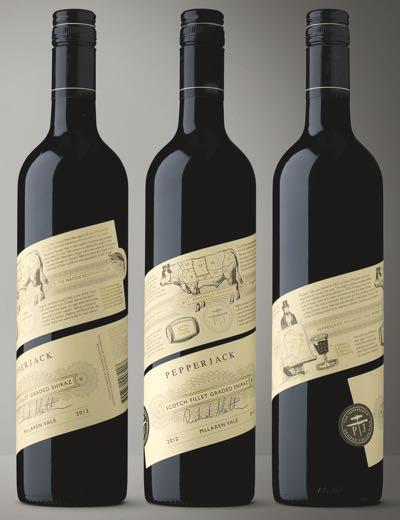
HERES her story… Yalumba
With an esteemed history in the Barossa, Yalumba needs little introduction. The brand has straddled heritage and innovation, entry level to uber premium, traditional to experimental, all under the watchful eye and guidance of the Hill Smith family.
Our partnership with Yalumba began with the development of The Caley – Yalumba’s flagship Shiraz Cabernet. Yalumba has had a long history of making award-winning Cabernet Shiraz blends, dating back to 1919. In 2012 Yalumba winemakers made a small quantity of Cabernet Shiraz from the exceptional 2012 vintage. Shown as a cleanskin in several wine shows, the wine scooped Riedel Trophy for the Best Winery of Show, The Great Australian Red 2015 Trophy and Tonnellerie Saint Martin Trophy for Best Wine $60 and over. In the words of Yalumba brand ambassador Jane Ferrari, “This is the wine we’ve been waiting 166 years to make”.
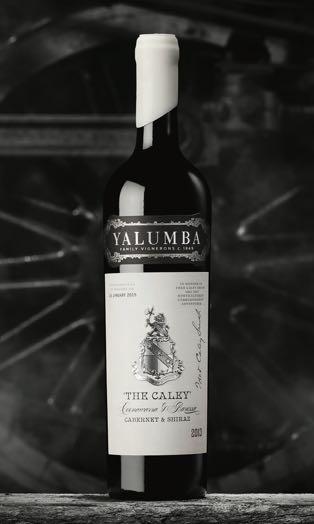
Named in honour of Chairman Robert Hill Smith’s uncle Fred Caley, this wine tells an important story within Yalumba’s history. An avid adventurer who criss-crossed the globe for 18 months to gather knowledge to help his family’s fruit growing business.
The Caley needed to have an oldschool luxury approach; a feeling of exclusivity and preciousness to the wine to encapsulate the specialness of the wine. Featuring the Caley family crest, the packaging uses all of the high-end production techniques available. The crest sits in a debossed panel, with the crest itself treated with a sculptural emboss, foiling and overprinting. Caley’s own signature is in a washed brown, mimicking his diary entries and avid letter-writing habits. The palette of typefaces used all speak to the period
of his global exploration. The accompanying tissue paper detailed the destinations and journeys of Fred’s 1893-1894 travels. Every bottle was gift boxed in a luxurious rigid box, complete with a small hardcover book detailing both the wine and its vintage conditions, as well as a photographic journal of part of Caley’s adventures.
Pepperjack
Pepperjack has long reigned as Barossa’s #1 Shiraz. Consumer trust has been built over decades of this brand delivering consistently delicious wine, as well as having a memorable and distinctive look and feel. At Denomination, we use a model of Distinctive Brand Assets based on the work of Byron Sharp – How Brands Grow (2011). Sharp argues that a brand needs at least four DBAs in order to increase the chance of consumers remembering that brand. In the case of Pepperjack, the combination of the angled label, the cream colour palette, the roundel and the connection to steak/food, has helped drive memorability of this brand.
When we evolved the core range of Pepperjack,
we wanted to retain but amplify these DBAs, as well as addressing some of the weaker areas of the identity and packaging design. Adding richness, depth and layering to the pack connects to the same characteristics of the wine style. The food connection is amplified with the addition of illustrations of kitchen utensils. The cream is fresher and more contemporary, but still connects back to the original. The branding is far stronger and helps drive recognition.
Along with the redesign of the core range, we extended the brand to other varietals that were completely new to the brand and previous red-wine positioning. The immediate success of varietals such as Chardonnay, Rosé and Grenache illustrated the strength of the brand beyond its Barossa Shiraz base.
Denomination has been working on the Pepperjack brand for a decade plus, developing new tiers such as Graded, Premium Cut and Certified, as well as Sparkling Shiraz. Throughout all of these tiers, Pepperjack’s signature DBAs feature but in different forms and treatments. The creative use of these assets in developing these tiers has been part of Pepperjack’s success story.
33 www.winenzmagazine.co.nz
THE ORIGINS OF
Pinot Noir
AROUND 1870 James McArthur arrived in the Waikerikeri Valley and settled at the end of what is now known as McArthur Road in Strathclyde, on the outskirts of Alexandra. At that time and in fact until the 1990s the land bordering the farm was like a desert, it was then that a source of water was found and the dream of a vineyard became a reality for the development company.
Located in the heart of the mountainous New Zealand Central Otago region, McArthur Ridge is dedicated to producing outstanding Pinot Noirs. The first plantings were 15 Hectares in 2002 followed by 72 Hectares in 2003 and a further 73 Hectares in 2004. The final 15 Hectares were planted in 2007. The first vintage was produced in 2006. While the production is large only a small percentage of carefully selected, handpicked grapes finish up in the hands of the Winemaker for the McArthur Ridge Label.
The Central Otago region is a land of stunning contrasts: barren challenging landscapes defined by snowy alpine peaks, broad rivers and deep, clear lakes.
The vineyards are sited on an elevated plateau, planted across a set of gentle northern slopes to capture maximum warmth.
Set at altitude, the Alexandra basin is the southernmost Pinot Noir producing area in the world,
the cool climate [-12.5 degrees], infertile soils and hot [42 degrees] but short-lived summers of Central Otago provide a pristine environment for winegrowing, especially Pinot Noir.
One of the youngest and most exciting of the world’s pinot noir regions, Central Otago has set an impressive standard and it is from here that you are brought McArthur Ridge Wines.

The 2020 vintage of the McArthur Ridge Southern Tor Pinot Noir is a miraculous wine – a wine for the ages; winning a plethora of awards and trophies globally right from its release date.

Fast forward one year and the 2021 McArthur Ridge Southern Tor Alexandra Pinot Noir is already on track to equal (if not surpass) its illustrious brother. Winning back-to-back trophies with the 2020 and 2021 vintages was an extraordinary feat, showcasing the incredible ability of the McArthur Ridges Alexandra vineyard to now consistently produce world class wines, under the guidance of head winemaker; Matt Connell.
This has been recognised with Bob Campbell (The Real Review) naming McArthur Ridge as one of the top NZ Wineries in 2023.
The Alexandra Collection is McArthur Ridge’s Premier Cru range, this super-premium Pinot Noir from the 2021 vintage is Ruby red in colour, with a bouquet of savoury red berry fruit, black cherry and vanilla. Add to this aromas of black forest berries, cloves and dark violets, finishing with soft stony notes.

Dry on the palate with a core of lush fruit, crisp acidity and savoury tannins, the 2021 Southern Tor has remarkable texture and length. The oak influence is obvious with baking spices, brown sugar and smokiness providing omnipresent structure.
A quality wine from first sip – to the last, fully deserving of each and every accolade, with surely more to come. An outstanding wine!
Winning the highest of accolades globally has meant that the Alexandra Collection has garnered considerable interest overseas, with export markets now established in Singapore, Australia, UK and China.
A wine to savour and enjoy – or if you have the inclination – cellar for up to 7 years.
34 | Spring 2023 WINE & TIME
MCARTHUR RIDGE SOUTHERN TOR ALEXANDRA PINOT NOIR 2021:
www.mcarthurridge.com
The greatest wines come from the greatest land.
Southern Tor
Pinot Noir 2021
NZIWS 2022 – Gold Medal

Decanter World Win

Awards 2023 – Gold Medal
IWC London 2023 –
• Trophy, Alexandra Pinot Noir
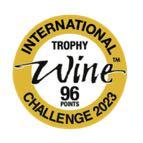



• Gold Medal
• 96 Points
FIVE
TOP
By Joelle Thomson
18.5/20
DROPS FOR SPRING
2022 MAIN DIVIDE CHARDONNAY
RRP $21.99
Warmer days and cool nights equal great flavour development in grapes and this full bodied, creamy and citrusy Chardonnay is the embodiment of that, offering outstanding flavours every vintage. Here is a wine that consistently offers extraordinarily good drinking for a modest price.

The grapes are given all the treatment of a higher quality, lower volume wine; fermented in French oak barriques with natural yeasts found on the grapes then matured in barrel til late spring. Spontaneous malolactic fermentation softens develops further depth in the wine, softening the wine’s natural acidity.
Delicious drinking and a real show stopper even if it cost a lot more.
Available in New World supermarkets and specialist wine retailers.
18.5/20
2021 GIESEN RIESLING
RRP $14.99
How do they do it? The Giesen brothers have kept the price and quality of this medium dry Riesling the same for over a decade, which is no mean feat with the price of everything else rising around us like flood levels in a cyclone. This is a blend of grapes from Marlborough and North Canterbury, two regions that are exceptionally well suited to making juicy Rieslings with concentrated flavours of limes, lemon zest and mandarin. And better still is that this wine is naturally lower in alcohol with 10% ABV, making for a luscious and lovely lunchtime or late afternoon glass or two.
Available at New World supermarkets and widely in retail.
18.5/20
2022 FORREST ESTATE ALBARINO
RRP $25.99
Beth Forrest fell in love with Albarino while working in Rias Baixas, a wine region in north west Spain where Albarino makes up over 90% of the
vineyard area. Not only did she love drinking it there but the similarity of that region’s climate struck her as being so close to New Zealand’s that this grape may just find a happy footing here. The rest is history and Albarino is now planted on Forrest Estate’s warmest vineyard site in Marlborough’s Southern Valleys. Winemaking is a straightforward cool ferment in stainless steel tanks to retain freshness and accentuate the vibrant citrus zest flavours, green olive and nutty aromas in this lovely wine.
Available in specialist wine stores, such as Regional Wines & Spirits, Wellington.
19/20
2020 HUNTRESS PINOT NOIR
RRP $51.99
An old vineyard, a young brand and an experienced winemaker make the 2020 Huntress Pinot Noir the best yet, by far. A good vintage helps too and since the 2020 summer was hot and dry, the Pinot Noir grapes ripened well so that winemaker Jannine Rickards was able to use 20% whole bunches in the fermentation to build structure, lift aroma and mouthfeel. This wine tastes youthful with tight firm tannic structure leading into smooth earthy flavours. The grapes come from one of Martinborough’s oldest vineyards, On Giant's Shoulders (formerly the original Pahi site). Depth of ripe dark plum flavours are supported by a firm full body. This wine has a long life ahead. Volumes are small and the wine has sold out now but some precious bottles remain in fine wine stores.

Available in specialist wine stores, in limited volumes.
17/20
ARA ZERO SAUVIGNON BLANC
RRP $18.99
One of the best zero alcohol wines yet to pass muster on my tasting table thanks to its recognisable aromatic flavours of passionfruit, fresh green apples and citrusy purity. This is a great new addition to the zero alcohol wines on the market.
Available in supermarkets widely.
36 | Spring 2023
WINE & TIME
TIA NELSON IS CROWNED BOTH AUCKLAND AND NEW ZEALAND YOUNG VITICULTURIST OF THE YEAR 2023
Congratulations to Tai Nelson, Vineyard Manager at Soljan’s Estate, who took out the title of Auckland/Northern Young Viticulturist of the Year 2023.

The first of the 2023 Young Vit regional finals was held at The Hunting Lodge in West Auckland on Thursday 8th June where contestants from across the large Auckland/Northern region competed for the title.
Congratulations also goes to Leon Henson from Vinetrak who came second and also Tobia Ficini from Stonyridge, who came third. The other contestants George Lewis and Nicole Reynolds also did themselves proud.
“It was great to see them giving it their all, wanting to stretch themselves as well as have some fun along the way.” Says Adam Yukich, Auckland/Northern Young Vit Chair. “It’s what Young Vit is all about”.
Tony Soljan from Soljans Estate was the guest speaker and captivated the audience as he spoke about the history and resilience of the West Auckland wine industry. It was inspiring to hear how early Dalmatian settlers paved the way for a successful New Zealand wine industry.
“It was wonderful to bring together pioneers from both the past and the future in one room. It was very powerful and this passion over the decades is what has and will continue to make our industry very special.” says Nicky Grandorge, Leadership & Communities Manager at NZ Winegrowers.
NZ ORGANIC WINE AWARDS 2023 RESULTS
PUBLISHED BY ORGANIC WINE AWARDS ON MAY 29, 2023
WE are please to announce the results of the 2023 Aotearoa Organic Wine Awards. Many thanks to all of the vineyards who participated in this years awards, as well as judges and other volunteers who made these awards possible.
NZ ORGANIC WINE AWARDS
‘RIEDEL VINEYARD OF THE YEAR’:
GIBBSTON VALLEY
NZ ORGANIC WINE AWARDS
‘RIEDEL WINE OF THE SHOW’:
GREYSTONE CHARDONNAY 2021
NZ ORGANIC WINE AWARDS
‘SUSTAINABLE VINEYARD OF THE YEAR’:
AMISFIELD
Champion Wines represent the highest scoring wines in their respective varietal classes.
CHAMPION PINOT NOIR:
GIBBSTON VALLEY CHINA
TERRACE 2021
CHAMPION SAUVIGNON BLANC:
LOVEBLOCK MARLBOROUGH SAUVIGNON BLANC 2021
Tai Nelson, 24, will represent Auckland in the National Final being held in Hawke’s Bay at the end of August. He will compete against other contestants from around the country, whose regional finals are being held over the coming weeks.
CHAMPION RIESLING:
CARRICK JOSEPHINE
RIESLING 2022
CHAMPION PINOT GRIS:
GIBBSTON VALLEY SCHOOL HOUSE
PINOT GRIS 2021
CHAMPION CHARDONNAY:
GREYSTONE CHARDONNAY 2021
CHAMPION SPARKLING:
QUARTZ REEF METHODE
TRADITIONNELLE VINTAGE BLANC
DE BLANCS 2017
CHAMPION SYRAH:
GIESEN CLAYVIN SYRAH 2021
CHAMPION ROSE:
TERRACE EDGE 2022 ROSE
37 www.winenzmagazine.co.nz
Tai Nelson from Soljans Estate in Kumeu, Auckland has taken out the prestigious title of New Zealand Young Viticulturist of the Year 2023.
Ultimate Queenstown Heli Wine Tour with The Rees’ Wine Director
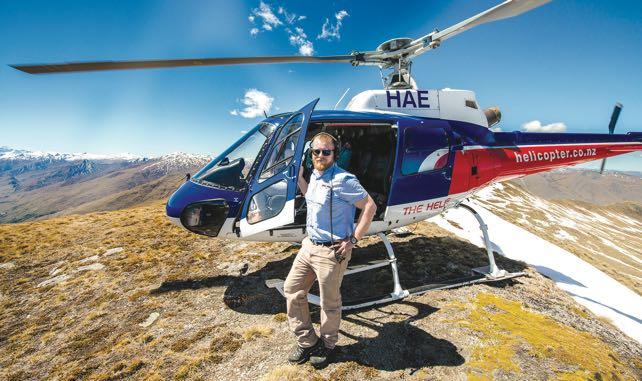

ALL from your private helicopter with a personal Rees’ wine guide, experience 180-degree panoramic views as you fly over the renowned Gibbston Valley and Kawarau Gorge. Enjoy a private winery tour and tasting at two premium local wineries, complete with a stop for lunch at one of our favourite restaurants, completing your culinary experience. Climb back on board your private helicopter before returning via your luxury transfer to The Bordeau Wine Lounge for a glass of Champagne with views of the Remarkables mountain range, reminiscing over this bucket-list adventure.
PACKAGE INCLUSIONS
3 Nights’ Accommodation in an Executive Lake View One Bedroom Apartment
Daily Breakfast in True South Dining Room
Complimentary Late Check out until 12 noon
Complimentary Fruit Bowl on arrival
Complimentary Car Parking and WIFI
Inclusive of all Car and Heli transfers
Inclusive of Gourmet Lunch
Inclusive of all selected wines/ beverages
TERMS & CONDITIONS
Package designed for a minimum of 2 people and includes a private Wine Guide
From NZD$1523.25 per person, per night



All rates inclusive of GST and in NZD and subject to availability at time of booking.
THE REES CULINARY EVENTS


Enjoy our exclusive, tailor-made Culinary Series Events which attract some of the top food and wine writers from around New Zealand and Australia. Extend your repertoire of fine wines or truly experience the award winning food pairings crafted by our Executive Chef, Benjamin Moon.
Indulge in some of the best cuisine and wine New Zealand has to offer, while taking part in thought-provoking conversation
surrounding viticulture, local produce and the wine industry.
THE REES GRAPE ESCAPE
If you love fine wine, then this is the perfect package for you. Go on a private tour in a luxury vehicle with local guides who will not only provide interesting information about New Zealand wines, but take you into four of the region’s best wineries.
During this exclusive experience you will be lucky enough to sit down with some of the best winemakers in the industry and learn more about the journey of vine to grape, to barrel, to bottle!
➽ To enquire or book, please email events@therees.co.nz
UPCOMING EVENTS 2023
The Rees Culinary Series with Felton Rd Wines

Friday 13th October 2023 | 6pm
BOOK NOW
Enjoy four courses and matching wines and a Welcome Drink & Canapes on arrival.
Access to special exclusive rates for wines showcased on the evening.

Winemakers Dinner - $185.00 per person
The Rees Culinary Series with Dhall & Nash featuring a Taste of France incl. Billecart-Salmon Champagne
Friday 8th December 2023 | 6pm
BOOK NOW
Enjoy four courses and matching wines and a Welcome Glass of Champagne & Canapes on arrival.
Access to special exclusive rates for wines/champagne showcased on the evening.
Winemakers Dinner - $185.00 per person
For more details or to secure your seat, please email our Events Team via events@therees.co.nz
38 | Spring 2023 WINE & TIME
Experience the very best of what Central Otago has to offer with this exclusive food and wine experience.




















CARETAKER: Setting the bar
By Gilbert Peterson
I’m there, according to the map on my phone. But where’s the entry? There’s a door but no sign or anything. I go on through anyway. A step into the unknown, down stairs into a club where everyone knows your name. Or no one. As private as you may wish. The welcome is genuine. A big smile from behind the bar, from Ben Maslin who turns out to be the manager. Yes I’m in the right place.
CARETAKER is a 1920s U.S. style speakeasy, an unmarked bar where those in the know and wanting to enjoy a prohibition-era drink, could (mostly) avoid the law. Caretaker in Auckland today replicates that sense of discrete intimacy if not the illicit suggestion implied. The bar hosts an elegant informality; you are invited to relax while your tastebuds are tended to, with the utmost of pleasurable sensations.
I ask Ben what’s it like, does he think, for the people who work there, since surely it has to be all about the staff?
All about the staff
“It’s such a cliché but we really are a family,” he says. “After all, we spend half our nights this close to each other. The owners care for the team and the team cares for each other and that permeates everything we do.
“Every week we have a staff party, or a dinner, and we go out together after hours - it’s a surreal bond, and it helps create this place as a community, a safe space for others to sit and chat. Or just sit. Customers constantly tell us how friendly and knowledgeable their servers were,

40 | Spring 2023
“Regular patrons can keep their own book here too where they record their best loved drinks.”
DistilledByDesign
which is a delight for us.
“We employ all our bar tenders on the basis of their personality, not on experience. Inexperienced bartenders don’t have bad habits to break and we can’t teach personality, but we can teach people to make super cocktails. A bar for the indecisive

“We’re also a bar for the indecisive. We don’t have a cocktail menu as such. Instead we ask you about your own preferences,
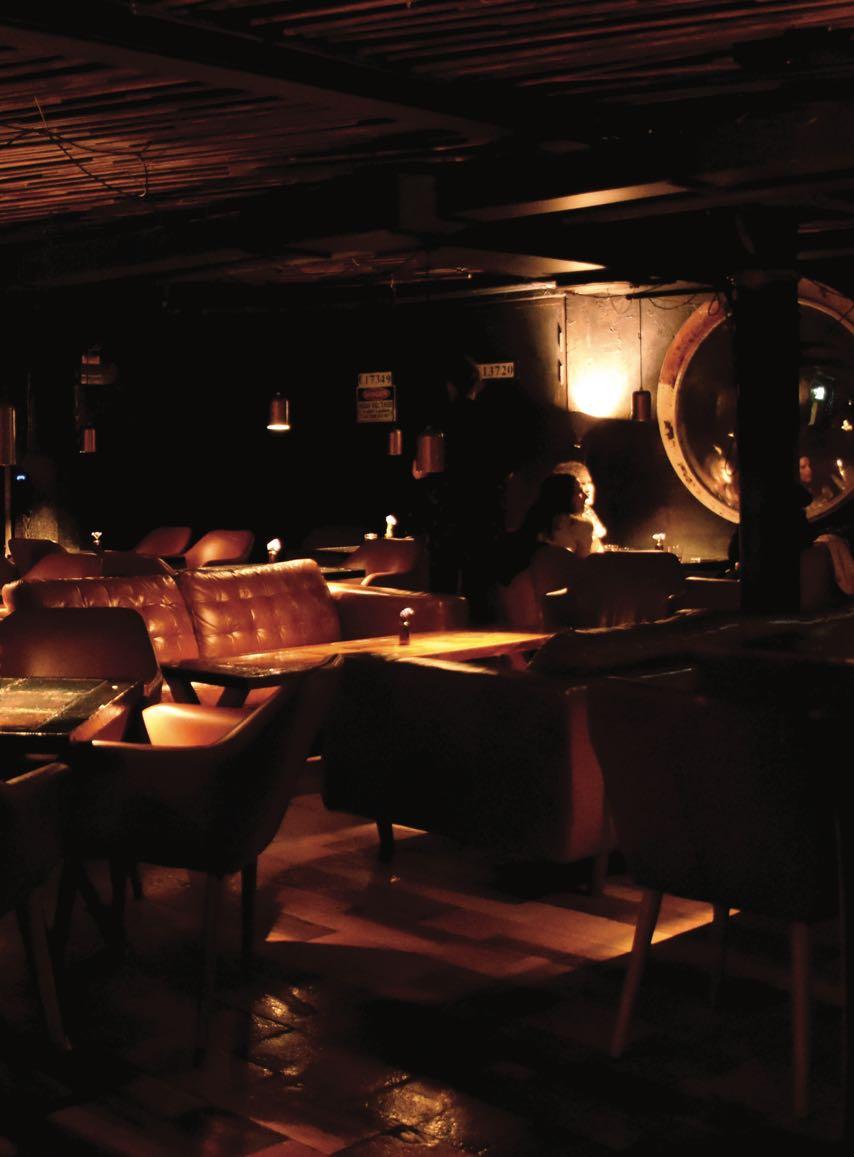
what you like, and dislike. Sweet, sour, bitter, spice? And we take all your prompts about your taste preferences to make something amazing just for you.
“We really enjoy introducing people to flavours and combinations new to them, based on the profile they give us. Our staff have exceptional knowledge of cocktails and their components and take pride in delivering just the right drink for that person, in that moment.
“Regular patrons can keep their own book here too where they record their best loved drinks,” Ben says, pointing to a rack of said books in the corner. I’m not sure any other venue does this.
“Of course we sometimes make mistakes and of course if you don’t like a drink we replace it. We can go for weeks without that happening then get three returns in one night. That’s no issue at all as we aren’t motivated by money - we just want people to come back. Why come back?
“I think people do keep coming back because we’re authentic in our approach.
We care enormously about our customers and their experience with us.
Everyone is welcome and everyone is important. If we get too crowded clients can go on a wait list or we’ll recommend another bar nearby they might like to try: La Fuente, or for a restaurant Amano perhaps. Being competitive is not a big thing in the Auckland cocktails scene. We help each other out. So why stop? I’m a foodie too and we can give notes on other venues.
“We have an incredibly loyal customer base of hospitality staff from other venues around Auckland and it’s our absolute pleasure to take care of them after they have spent their evening taking care of others.
“Word of mouth is huge for us. I found it very cheering when someone from the mid west of the US said our bar had been recommended and they sought us out.”
41 www.winenzmagazine.co.nz
Manager Ben Maslin.
DISTILLED BY DESIGN
Why Ben?
I ask Ben more about himself. He’s been with Caretaker and sister bar Deadshot in Ponsonby for about two years. He was previously in hospitality in London’s East End for 10 years or so. And amongst other outdoors things, a dive instructor spending several months in the Galapagos. Looking for more outdoors is how he arrived in Aotearoa New Zealand, and fell in love with the place.
Ben tells about another lovedrawing, and tattoo art. He says he started it to wind down in the early hours after work, before sleep, and found he really enjoys it.
Make your own?
Cocktail Masterclasses at Caretaker are a thing. Owners Alastair Walker and Heather Garland run them on a semiregular basis, with the focus on a different spirits base each time; gin, rum, tequila, whisky, repeat. Takers get five half cocktails as Ali explains all about how and why they make the drinks the way they do.
For a moment we exchange tales about the pleasures of gin. “Some spirits I absolutely adore,” Ben says. “A Martini with Kakapo gin and elderflower - we have a massive back bar and can get really specific. It’s a beautiful thing. “


He enthuses over Pokeno whisky. They don’t have an age statement he says but clients keep saying they are the equal of many established brands.
“We absolutely love to support our local spirit makers. Apart from using and enjoying their fine products, we get to visit local distilleries, talk with the makers and gain a deeper knowledge of their processes and products.”
Favourites include Elsewhen Applejack, Just Vodka, and Cardrona, Pokeno, Thompson and Waiheke whiskies, and 1919, Roots and Kakapo gins. Caretaker is open 7 days a week from 5pm until 3am.
42 | Spring 2023
“A Martini with Kakapo gin and elderflower - we have a massive back bar and can get really specific. It’s a beautiful thing.”
A heartfelt endeavour
Kākāpō Distillery has not only captured the essence of Aotearoa in its bottles but is also carving a path towards a more sustainable, ecoconscious future.
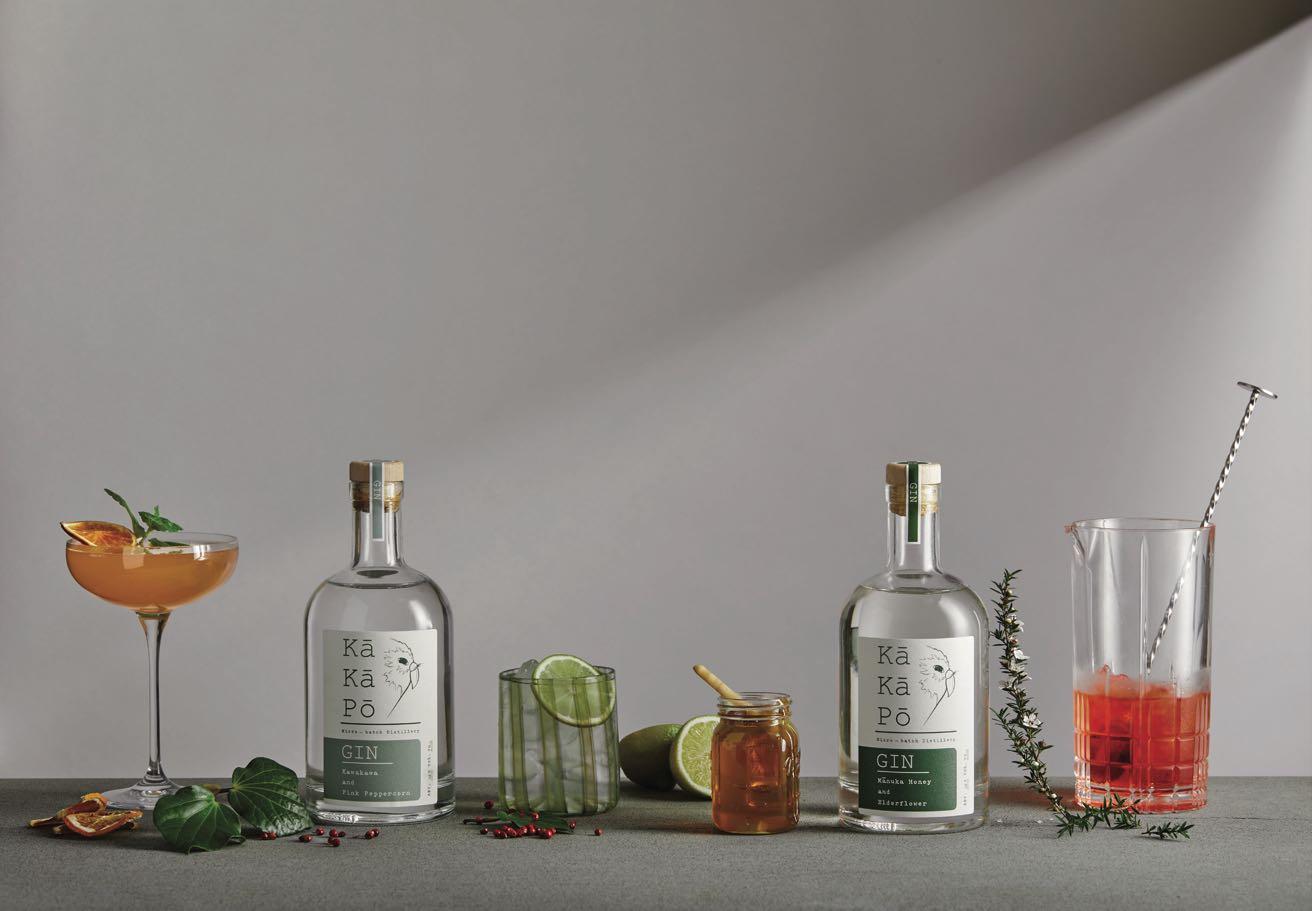
The business was founded on three key principles: a love for Aotearoa, a commitment to
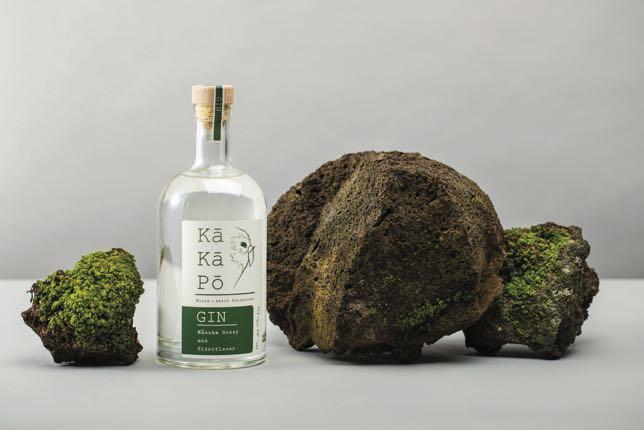
Celebrating 30 years of Toast
Martinborough
Make your way to Martinborough on Sunday 19th November to celebrate the 30th year of New Zealand’s most esteemed wine and food festival.
What’s in store for this year’s festival?
As Toast celebrates its 30th year, the 2023 festival promises to be truly memorable.
Festival-goers will be welcomed to indulge on a journey across eight picturesque festival sites, featuring twelve local vineyards. From revered favourites like Palliser Estate, Ata Rangi, Te Kairanga, Martinborough Vineyard, Luna Estate, Tirohana Estate, Escarpment and Moy Hall to exciting newcomers such as On Giants Shoulders, Huntress, Big Sky Wines and Stad_ko Wines. To complement the exceptional wine selection, Martinborough Brewery will create a special festival beer, adding a unique touch to the beverage experience. Supported by the region's finest food and the regions most revelled musicians, it will undoubtedly be a blissful day amidst the vines.
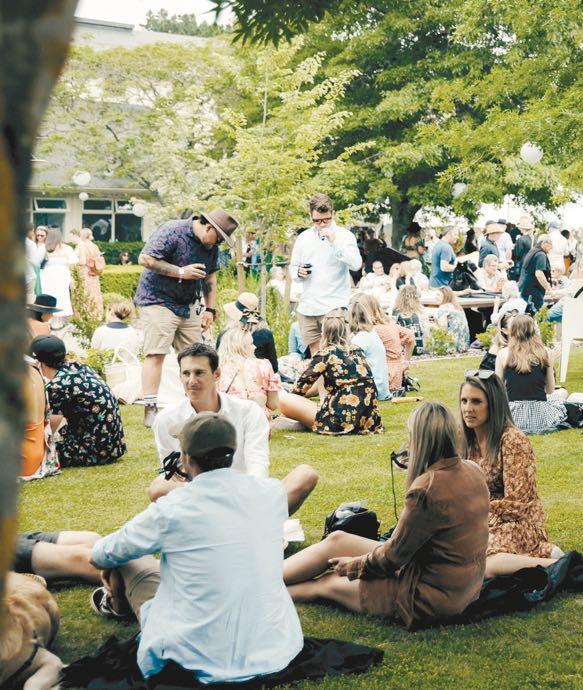
This year, festival-goers will have the opportunity to enjoy an elevated level of luxury at Toast while delving deeper into Martinborough's exquisite wines. Exclusive VIP experiences will be available at Palliser Estate, Ata Rangi and The Runholder festival sites.
Festival-goers have the opportunity to add a touch of nostalgia and grandeur to their Toast experience with a heritage excursion train making its way over the hill from Wellington. The bus service
connecting Wellington, Palmerston North and various locations within the Wairarapa, will continue to be available for festivalgoers as in previous years.
Tauherenikau Camping Village will also be back for a second year, with their thoughtfully designed two-night glamping, motorhome and caravan packages, nestled amidst the beauty of Tauherenikau.
This year the festivities will extend beyond the Sunday, with a program of supporting pop-up events curated by local Martinborough businesses. From Friday the 17th to Monday the 20th November,

44 | Spring 2023
NZ Wineries
visitors will have the opportunity to discover an array of exciting experiences. From gin garden parties to intimate tasting sessions to delightful treats amidst the olive groves. The weekend will be a showcase of Martinborough's best.


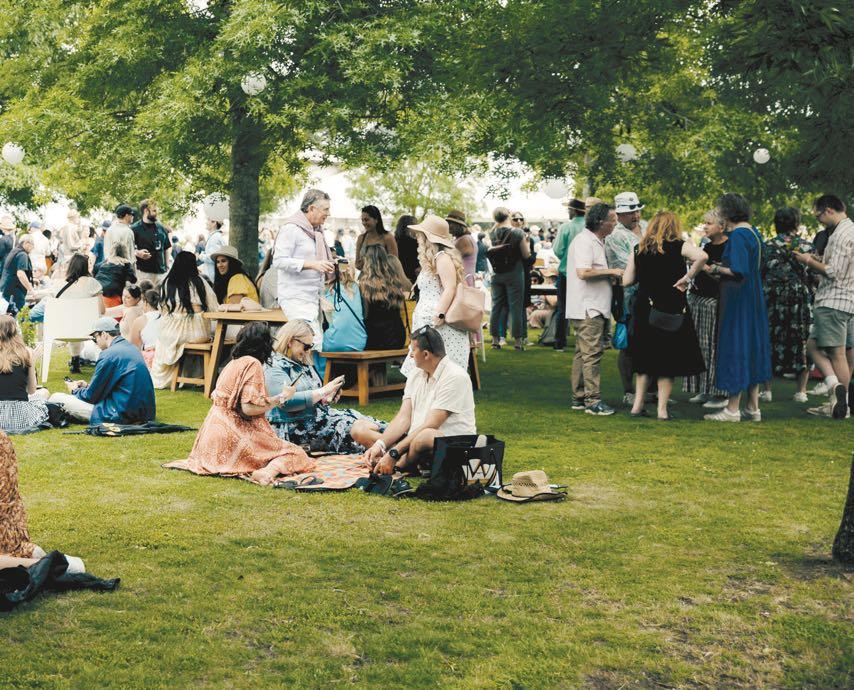

Ariel Codde, General Manager of Toast Martinborough, encourages people to act quickly to secure tickets “Our 30th year is set to surpass all expectations, featuring an exceptional event programme
and a bustling atmosphere in Martinborough throughout the festival weekend. Don’t miss out on what’s going to be an unforgettable celebration!”.
Year after year, Toast Martinborough honours tradition while embracing innovation. It pays homage to the rich heritage of winemaking in Martinborough while also celebrating the forwardthinking approaches that drive the region's continued success. The festival is an embodiment
of Martinborough's position as a true gem in New Zealand's wine landscape—a place where glasses are raised, flavours are savoured, and everlasting memories are created. So, mark your calendars, gather your loved ones, and get ready to join us as we embark on a flavourful journey at Toast Martinborough on Sunday 19th November!
To learn more, visit www.toastmartinborough.co.nz
FESTIVAL of WINE, FOOD and MUSIC
SUNDAY 19 NOVEMBER 2023
Escarpment is a quality focused winery is based on Te Muna Road, Martinborough.

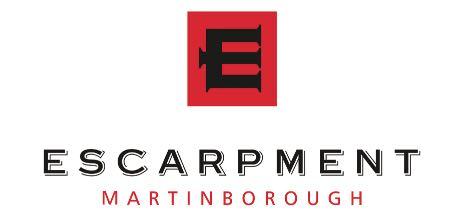
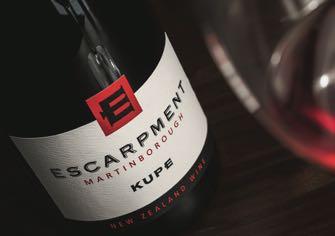
‘Te Muna’ in Māori, means ‘secret’ or ‘special place’ At Escarpment Winery, their purpose is to make wines that reflect these special attributes of the land, this special part of Aotearoa, New Zealand. These are wines with an identifiable structure, complexity and fruit expression that reflect their distinctive sites and their regional Martinborough accent.
Escarpment Kiwa 2021
Martinborough Pinot Noir single vineyard
Winemaker’s notes:
The Kiwa vineyard, in the township of Martinborough is one of the mature plots planted in the district, with a combination of deep alluvial gravels for which the Martinborough Terraces are renowned.
A complex and spicy wine, the fruit was fermented with the inclusion of some whole bunches. After pressing it was matured in 35% new French oak barriques for 20 months then bottled without fining or filtration.
“Intense, ripe, red-fleshed plum, dark cherry/ berry, anise and oak spice flavours. Accessible yet structured pinot noir with obvious cellaring potential. A classic Martinborough wine in form and flavour profile”.
 - Bob Campbell
- Bob Campbell
KUPE Pinot Noir
WineNZ tasting impressions:
Layered flavours. Cherry aromatics, structured tannins extend to the length of the palate. A violet colour with perfectly ripe fruit. Medium weight with supple tannins and a savoury finish. Aromatic stone fruits with wild berries well balanced and leading to a tasty finish.
An attractive structured palate with many layers of ripe dark berries layered nicely. A long lingering finish. 2020 vintage, 97 points Bob Campbell. Moderately intense wine with impressively layered flavours that include floral, dried herb, cedar, mixed spice, and baked-earth characters.
ESCARPMENT WINERY LTD. 275 Te Muna Road Martinborough T +64 6 306 8305 E info@escarpment.co.nz
Visit our Tasting Room (by appointment only – book online) NZ WINERIES
and slowly down the walls of the decanter.
Decanted younger wines will become smoother and rounder, as they would through cellaring. Their age makes them more resilient so Mark suggests turning the bottle upside down and letting it vigorously splash into the decanter. When selecting the right decanter for you, consider the aesthetics, function, and your budget. Choose a piece that you feel comfortable using, but one that also adds theatre to the wine service. Wine is all about fun, says Mark, and a decanter is another way to elevate your experience.
CHOOSE THE RIGHT GLASS
How to Elevate Wine Service at Home
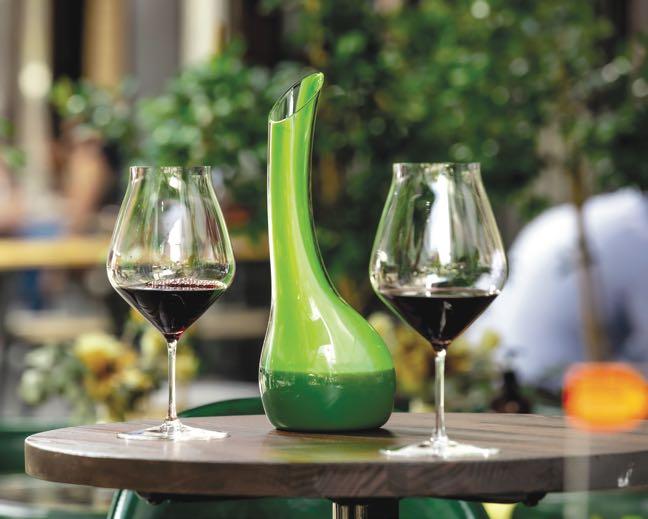
The perfect glass of wine goes far beyond finding the ideal vintage from the right region of your favourite variety. Mark Bauldertone, Managing Director of RIEDEL New Zealand, provides some easy tips to elevating your at-home drinks for a better experience.
GET THE TEMPERATURE RIGHT
Ever smelt a red wine and felt like your nostrils were burning? That's the alcohol aromatics, an effect that can arise from serving wine at the wrong temperature.
The concept that white wines should be ice cold and red wines should be served at room temperature is now totally outdated. We prefer to keep our homes around 21-22°C, which is too hot for our reds when the recommended temperature for reds is between 13-17°C.
If your red wine isn’t being stored at the optimum temperature, pop the bottle into the fridge for 30
minutes before opening it or plunge it into a bucket of ice and water for 10 minutes.
On the flip side, icy whites and champagne lose their character –you’re better off aiming for 7-13°C depending on the style and weight.
DON’T FORGET TO DECANT
Any wine that benefits from ageing will benefit from decanting, Mark says.
Wines over 10 years should be decanted to gently aerate and separate any sediment. Open an hour or two before serving, letting the wine flow smoothly
The world of wine is based around varieties, and the only glassware designed to give you the optimum experience is a RIEDEL Grape Varietal Specific glass. “Every wine smells and tastes different, and only RIEDEL glasses are tailormade to enhance each varietal’s specific characteristics so give you maximum enjoyment,” says Mark.

A generic glass will get the wine from the bottle to your mouth, but it won’t do much more. The beauty and joy of wine is in celebrating what makes them unique, and that’s what a RIEDEL glass is designed to do.
Starting from scratch? Mark suggests selecting two or three varietal glasses based on your drinking preferences. For instance, “If you love chardonnay and pinot noir, then start with those pieces and build from there. It’s also perfectly acceptable to start with one glass in a larger quantity for dinner parties and have a couple of your varietal-specific favourites in the cupboard for yourself.”
To find out more, visit RIEDEL.com
47 www.winenzmagazine.co.nz
ENTER NEW ZEALAND’S AMBITIOUS
“Bring Back Nature” project
By Charmian Smith
An ambitious 30-year project to bring nature back into the vineyard and achieve carbon zero emissions is underway at Yealands Seaview Vineyard in Marlborough. Michael Wentworth explains the undertaking and shows Charmian Smith around.
AS you drive along Seaview Road from Seddon look down to the left to see vineyards stepping down the wide terraces to the Awatere river far below. It gives you an idea of how the river has carved this great valley south of the Wither Hills, 25k from Blenheim. Over the past couple of decades this once barren land has been greened with vineyards.
Then the road turns away from the precipice and you enter one of the largest, Yealands’ park-like, 270 ha Seaview vineyard. Neatly mown grassy berms with regularly spaced exotic trees line the road and rows of cleanly hedged vines march up and down the rolling landscape as far as the eye can see. It appears a neatly groomed monoculture of vines with occasional trees.

Precisely underneath each row of vines run bare strips of earth cleared of weeds by herbicide, and between the rows is a carpet-like grass sward. It looks manicured.
Then you notice that every few rows, 10 to be precise, instead of grass, taller blue and white wildflowers wave between the vines.
This is to encourage beneficial insects and also improve soil structure by increasing organic material, says Mike Wentworth,
general manager of sustainability and strategic projects for Yealands.
Other inter-row cover crops such as oats, peas and beans also contribute to soil health and structure.
“It’s difficult to get the grounds team to stop making it look like a billiard table which takes a lot of diesel,” he says.
“I guess that’s the outward reflection of the biodiversity project we are working on.”
It has been a change of mindset for vineyard team, that this biodiversity is what a vineyard should look like, not a super well-managed postage stamp, he said. However, their efforts are being recognised. Yealands topped the regeneration and carbon reduction categories at the 2022 International Green Apple Awards awards, run by global nonprofit The Green Organisation, to recognise environmental best practice around the world.
“We believe creating a more biodiverse environment makes for a healthier, more resilient vineyard – one that’s also more resilient to climate change,” he said.
Reducing herbicide use in the vineyard is ongoing work - the bare strips under the vines are narrower than they used to be.
PHOTOS: COPYRIGHT OWNED BY JIM TANNOCK PHOTOGRAPHY LTD MARLBOROUGH, NEW ZEALAND www.jimtannock.co.nzl
Photos were sent by Mike Wentworth Michael.Wentworth@ Yealands.co.nz
48 | Spring 2023 NZ WINERIES
Keeping under-vine weeds at bay is always a problem, and organic vineyards usually mow or cultivate under the vines, but that uses more fuel. Tractors and other heavy machinery also compact the soil every time they pass through which can harm roots and damage soil structure.
Yealands already has some organic vineyards and what they learn from them is being applied elsewhere, Mike says..
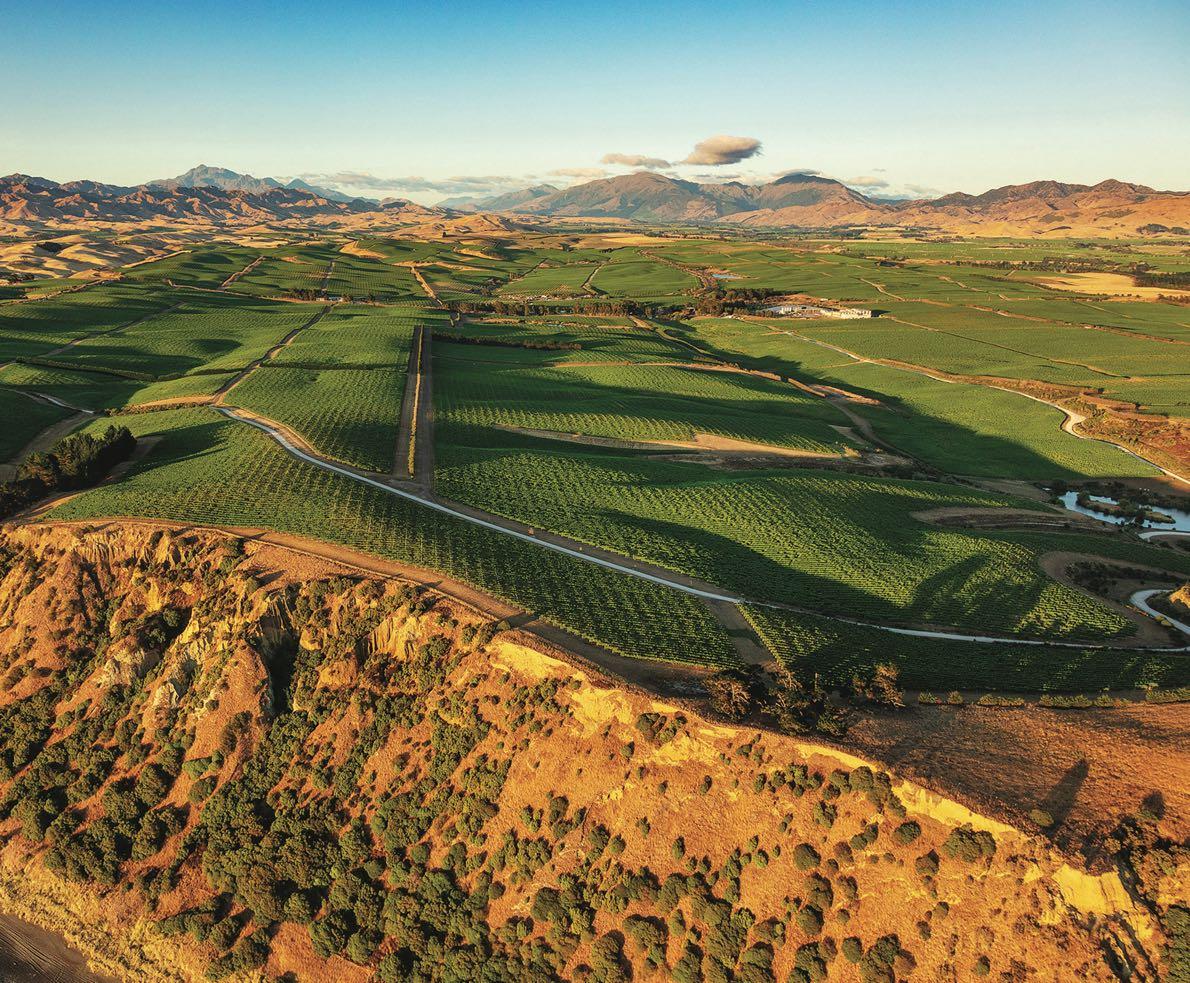
In Mike’s EV we continue along the signposted White Road which takes visitors around the vineyard, driving past the winery and its nearby composting area for grape skins, pips other winemaking waste. A biochar facility is to
be installed which will not only sequester carbon but the resulting char mixed with compost will produce healthier soil with more beneficial microbes and greater water holding capacity which reduces the need for irrigation, Mike says.
Large bales of last winter’s prunings are stacked ready for burning to heat water for the winery. Burning them produces about 20 tonnes of carbon dioxide a year compared with about 200 tonnes from using LPG, he said They aim to reduce their carbon emissions by 5% a year.
We come to a clifftop lookout and park near another “bug bank” of wildflowers, a mix containing
buckwheat and lacy phacelia. These attract beneficial insects that help reduce vine pests and has replaced a patch of grass that needed to be mown.
A hundred metres below is the wild grey, sandy beach but there are also extensive views up and down the coast south to Cape Campbell, north to the White Bluffs and across Cook Strait to the hills around Wellington and Palliser Bay, and even, on a fine day, Kapiti.
It’s windy, and the constant sea breeze brings what winemaker Nat Christensen calls a ”salty mineral character” to the wine. It also reduces disease and slows ripening, giving grapes longer to develop flavours.
49 www.winenzmagazine.co.nz
Right on the coast, the rolling terrain of Yealands’ Seaview vineyard stretches towards the Kaikoura Ranges. The White Road takes visitors through the vineyard, past the lookout, Butterfly Gully and wetlands.
The cooling sea breeze particularly affects vines closer to the ocean. They take longer to establish, their leaves are more brittle and the crops smaller, Mike says.
Seaview is cooler and more windy, but has less rain than the Wairau Valley around Blenheim and Renwick, The grapes tend to have more acidity, minerality and fresh herb characters, but there is also less disease pressure with the wind blowing away fungal spores. The growing season is longer, bud burst here happens earlier and harvest is later than in the Wairau.
“As a result fruit hangs on vine longer and flavours take longer to mature. Because it cooler we get smaller berries and thicker skins so we get greater fruit intensity as a result,” Mike says.
He explains the soils were originally pushed out of the ocean so are salty and low in organic matter. The shallow topsoils are wind-blown loess and need vegetation cover to stop it blowing away or becoming puggy when it rains. Composting and inter-row cropping make big a difference to soil and vine health.
The many slopes and gullies across the extensive vineyard provide different environments
for each block of vines. The winemakers keep parcels of fruit separate throughout the processing, allowing many options for blending.
Mike’s pride and joy is Butterfly Gully, the most sheltered part of the vineyard where they have planted native swan plants and native trees to attract butterflies.
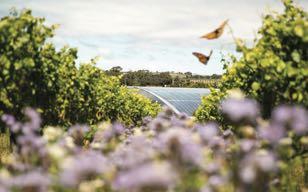
Visitors can walk through the replanted area, the first commercial garden to be certified by the Moths and Butterflies of New Zealand Trust, which has helped with advice and information, he says.
They are also working with DOC to protect coastal land prone to erosion.
This is all part of Yealand’s biodiversity project to bring nature back into the vineyard and plant a million native trees, a 30-year ambition that is now up to year 3.
A major part of the project is to restore Station Creek, a waterway that flows from one end of the property to the other. When the original vineyard was planted about 18 years ago the creek was piped underground and vines planted above.
“This is part of trying to undo some of the wrongs of the past,” Mike explains.
“The water was trying to return to its natural watercourse as water does, so we’ve removed the vineyard, reestablished the watercourse and planted with riparian planting either side. Once all these trees mature, we’ll have cooler water running down which means it can carry more oxygen.”
By June the creek will be running alongside the winery and within the next three years will be flowing from the very top of the vineyard to the bottom.
It’s about bringing nature into the vineyard rather than controlling nature. Part of this project is also to reestablish and plant wetlands.
The White Road brings us back to the winery building, its curved roof reflecting the rolling landscape. Water from the roof is recycled through ablutions or goes out to wetlands.

50 | Spring 2023 NZ WINERIES
A large solar array covers the curved roof of Yealands’ winery in the middle of the vineyard.
Wild flowers are planted between the vine rows to attract beneficial insects. In the background are the solar panels on the winery roof.
Designed to withstand earthquakes, the building wasn’t damaged during two major events in 2013 and 2016, but many of the tanks inside were. To reach the damaged ones deep inside, a side of the building had to be dismantled and other tanks moved out of the way. Despite it being more energy efficient to have them inside the insulated building, they have now built the large tank farm outside with new earthquake restraints.
“We were here for the first one, in 2013. It was quite scary, but the building performed as it should have and everyone was safe.”
On the northern side of the roof are 1300 solar panels, at the time the largest installation in the country. It still supplies about 19% of their total electricity requirement. Nevertheless a new solar array 10 times larger than that on the roof is planned for a site nearby. It will
bring them up to 60-65% self sufficient in electricity - not more because they are not installing batteries, he said.
Small baby doll sheep will graze under it. Introduced by the founder, Peter Yealands, to graze the vineyard, they are too short to reach the grapes. However, to effective to cover the whole vineyard they would need 10,000 but have only 160. They contribute but they are actually quite dumb, he said with a laugh.
Merino sheep also graze the vineyard after harvest, between May and August.


One of the most difficult parts of offsetting their carbon footprint is the packaging and freight which can be around two thirds of the total.

They use lightweight bottles and packaging wherever possible, and are increasingly shipping wine in bulk to the UK and Europe and bottling it there and will soon do so to the US as well.

51 www.winenzmagazine.co.nz
“Plantings will attract insects and sheep graze openly to add value to the project.”
Blue phacelia between the rows attracts beneficial insects to the vines.
Butterfly Gully, a short walk with information about the butterflies and moths attracted by the native plantings.
Butterfly Gully with a track and information, is planted with natives to attract butterflies and moths.
Riparian plantings alongside the restored Station Creek is part of Yealands’ 30-year biodiversity project.
“You are shipping wine as opposed to packaging and the airspace in your packaging. However, customers value estate bottled wine so all our Estate range wines are bottled in Marlborough and shipped,” he said.
Not surprisingly, Yealands wines seem to reflect the vineyard. It was a breezy grey day when I visited, but the three sauvignon blancs I tasted, the Reserve, the Single Vineyard and the Single Block, seemed to encapsulate the sun, sea and wind.
All three leaped out of the glass with their wonderfully pungent aromas wafting hints of ripe fruit and fresh sea breeze, followed by enlivening fruit tempered by a savoury element, a suggestion of mineral, and varying degrees of power and structure depending on the level of wine, but always an invigoratingly crisp finish like a breath of fresh air.
When she started at Yealands about nine years ago, winemaker Natalie Christensen said she thought she knew the tomato-leaf character of Awatere sauvignon but tasting with the previous winemaker she realised she didn’t.
*I think the Seaview sauvignon blanc is unique in its own right, it’s that texture and weight that comes through. It’s got beautiful bright acidity but there’s that salty, kind
of briny character, that gives the wine power and elegance at the same time.
“I was like ‘wow, these wines are something special'. It’s been really interesting in my time here to see these wines get recognised in international competitions, our sauvignon blanc especially. So we do have something really unique out here.”
Yealands Single Vineyard
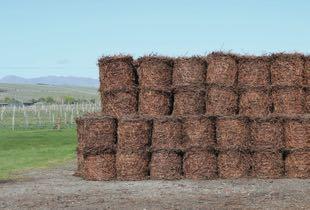
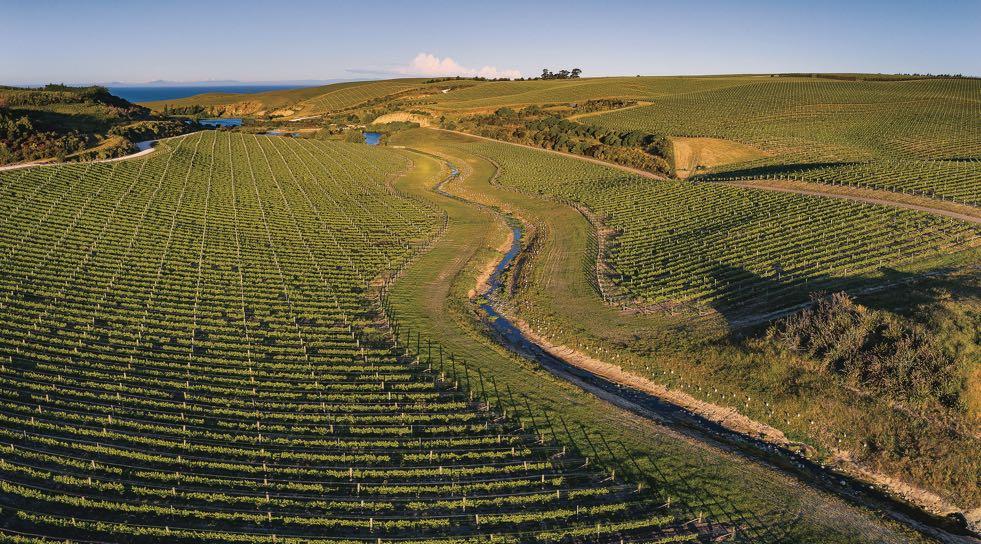
PGR is a blend of pinot gris, gewürztraminer, riesling created in response to their UK importer who wanted something to go with Asian fusion food. Such field blends - all varieties picked on the same day and fermented together - have become popular in the natural wine movement but this bend is also traditional in the French region of Alsace.
Natalie believes albariño is a variety with a great future here. She worked in Rias Baixas in Galicia on the Atlantic coast of northeastern Spain, the heartland of albariño, where many of the vineyards are on coastal sites like Seaview. Her the first vintage of the newly planted albariño here was 2022. She made it simply to see what the pure fruit expression was.
She thinks now she has a feel for it, this next vintage she will put some into old oak barrels and encourage a couple to go through
malolactic, so she has a few blending components.
This initial vintage from young vines was fragrant, with bright fruit suggesting yellow plums, a slightly oily texture and crisp finish.
She also makes several levels of pinot noir. The Single Vineyard 2021 hints of herbs, but backed with sweet fruit - red cherries and ripe plums - with a vibrant finish.
While many winemakers put pinot noir through a cold soak for several days to extract flavour and aromas, she won’t do it if the fruit comes in warm from the vineyard, as she is mindful of the emissions from the chiller. Instead she aims to have the fruit picked at night or in the very early morning so it comes into the winery already cold.
That’s the beauty of the sustainability space. There’s away more you can be doing and focusing on, say Mike and Nat.
52 | Spring 2023 NZ WINERIES
Restoring Station Creek, and planting natives along it and on bare slopes is well underway at Yealands.
Last winter’s vine prunings baled ready to burn to produce hot water in the winery. Compared with burning LPG, this reduces their carbon footprint by about 200 tonnes annually.
Best New Zealand Wines & Food Matches

READ ABOUT NZ AWARD WINNING WINES TASTED AND RATED FOR YOU. SEE WINNING WINES FROM EVERY REGION.
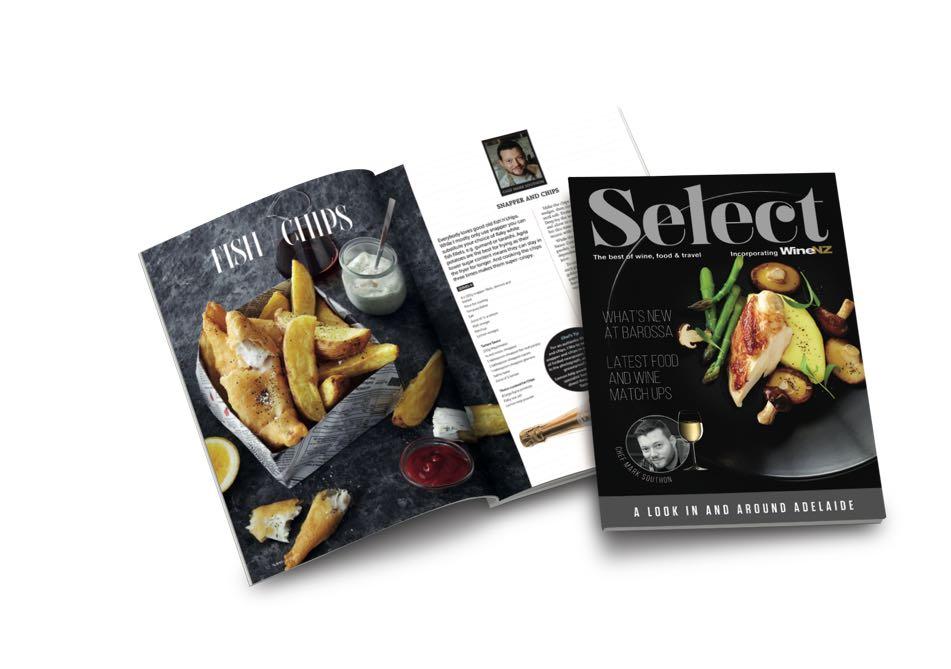
Go to... isubscribe.co.nz and search Wine NZ.
SPECIAL SUBSCRIPTION OFFER.. Annual 4 issues reduced to $29.50 2 Year 8 issues reduced to $49.50
What influences wine price differences?
By Charmian Smith
Why are some wines more expensive than others? Is it worth paying $35 or $60 or even $500 for a bottle of wine when you can probably get something quite drinkable from the supermarket for around $15?
Charmian Smith talks to Saint Clair winemaker Kyle Thompson about what goes into more expensive wines compared with cheaper ones.
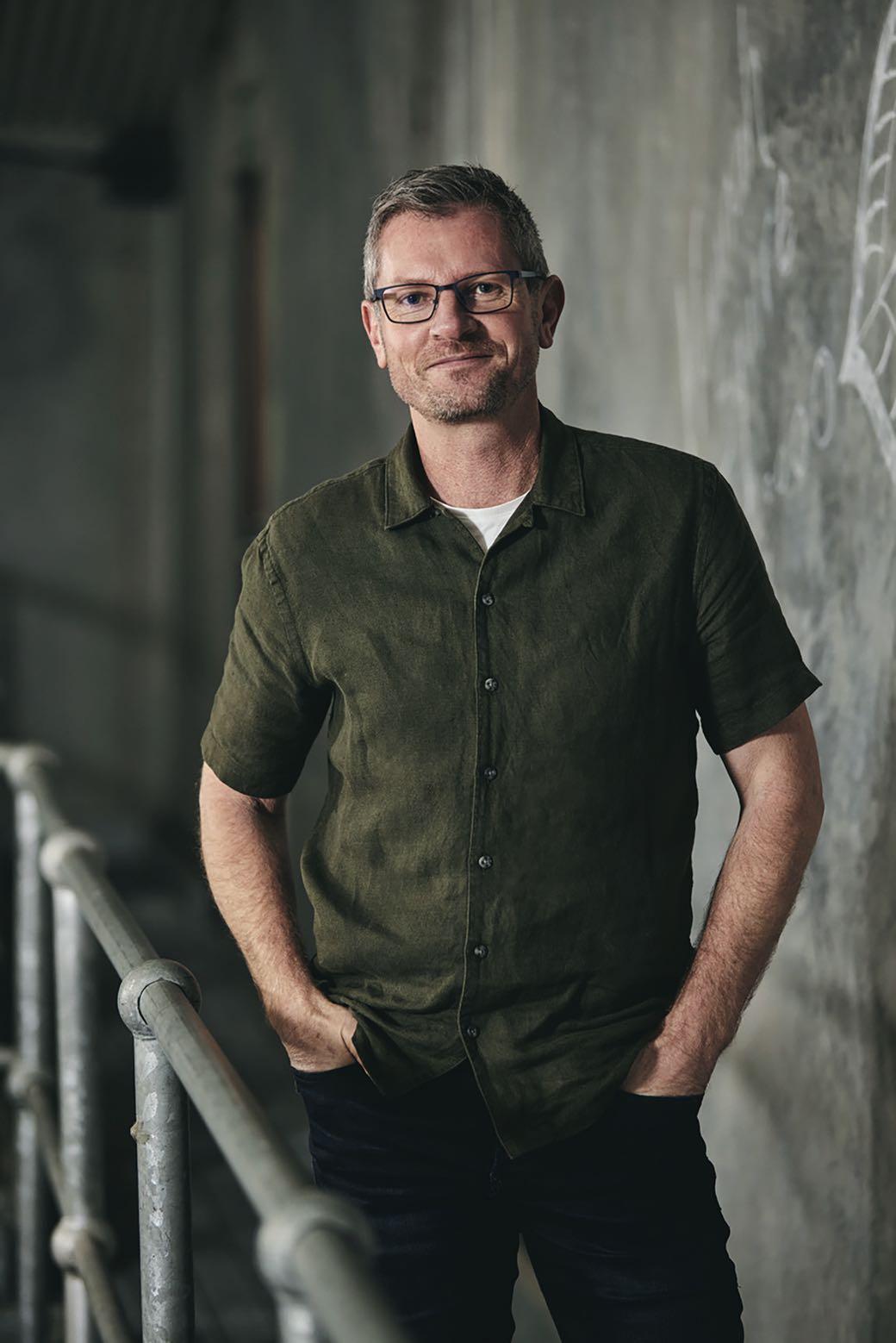
54 | Spring 2023 NZ WINERIES
Kyle Thompson, senior winemaker at Saint Clair Family Estate likes his wines to speak of where they come from and to overdeliver for their price point.
THE price of a bottle of wine is sometimes said to be a function of reputation, demand, rarity and marketing/hype. But location comes into it too, the more specific the place the wine comes from, the more likely it is to be expensive - so a single block wine is likely to be more expensive than a generic regional wine - but this is not always the case.
Economies of scale can enable large companies to produce wine relatively cheaply. On the other hand for some small vineyards with high reputations, demand may outstrip supply driving prices up, especially on the secondary market such as at auctions.
Then the winemaker’s methods and decisions can contribute to the price of a wine. How much time and money have they spent on making it? Lower crops increase costs but also can increase the quality and flavour of the wine. Is it machine or hand harvested? Is it made quickly and simply in large stainless steel tanks or does it go into expensive oak barrels to mature for long periods? Is it an expensive, heavy bottle packaged in its own flash box? And, above all, what is its reputation?
Then, from the buyer’s point of view, what occasion is it intended for - everyday drinking, a party where it’s put on the table along with other BYO bottles? Or perhaps a special intimate occasion, or to impress others at a dinner party?
I talked to Kyle Thompson winemaker at Saint Clair in Marlborough about the differences between their four levels of wine, Vicar’s Choice, Origin, Pioneer Block and Reserve, which vary from around $16 for Vicar’s Choice to around $46 or more for Reserve wines.
He explained Vicar’s Choice is their “entry level” wine made to a price point from a mix of vineyards.
Origin, the estate range, also comes from vineyards across Marlborough but particularly from those that produce more flavoursome grapes.

Pioneer Block wines are from lowercropping, single vineyards and express the special characteristics of their terroir or place. Each year there may be several Pioneer Block wines of each variety, each from its own vineyard, but these may change from year to year depending on growing conditions and the quality of the grapes
Reserve wines are made with a lot of winemaker input from some of the best grapes, but in the same style each vintage.
“It starts with a broad version of what Marlborough varietals can be and gets more acute as you get to Pioneer Block. And at Reserve level you have some winemaker manipulation and selection. You are getting the best of best and paying for it. The prices reflect that,” he said.
Each batch of grapes that comes into the winery is treated separately. The winemaking team tastes and evaluates them, the first of many evaluations they do throughout the winemaking process.
Some vineyards regularly score highly year after year. In general, the higher priced wines come from vineyards that produce more exceptional flavours. The crops will be lower which concentrates the flavours,
Any fruit or batch of wine that doesn’t make the grade for whichever label it was intended for can be downgraded to the level below, or even into one of Saint Clair’s other commercial export wine brands.
For example, chardonnay grapes that look good may go into more expensive oak barrels. Others that may not be so good may get their oak flavours from a large stainless steel “teabag” of toasted oak chips suspended in the tank.
“We play with different components. More time will be spent with it if the fruit deserves it,” he said.
Many Marlborough winemakers say the best chardonnay and pinot noir come from the Southern Valleys rather than the alluvial soils of the plain.
“It’s the glacial outwash, devigorating clay soils, that allow chardonnay to put its energy into the berries, and chardonnay has such tiny berries anyway, some of them are just pea sized, so you want that energy to go to the grape, not to the canopy,” he said.
“Whereas sauvignon blanc is big and vigorous, likes water and likes its feet down, it doesn’t want to be restrained. Chardonnay and pinot noir need to be devigorated and held back and clay does that, and clay gives nutrients at the right time.”
55 www.winenzmagazine.co.nz
“You are getting the best of best and paying for it. The prices reflect that.”
Some of the better sites also are less susceptible to disease because there’s more airflow through the canopy. Shading from trees can create an environment favourable for powdery mildew to which chardonnay is particularly susceptible.
Saint Clair makes two Vicar’s Choice chardonnays, one is unoaked, the other has some oak treatment.
It’s from a blend of vineyards, tank fermented, and for the oaked version with or oak beans (a “teabag” of toasted oak cubes) suspended in it which gives it a smoky hint. It’s left on spent yeast lees for a short time which adds a suggestion of nuttiness, and it has a fresh finish. It’s an easy drinking wine that is likely to be finished quickly if it’s left on a table at a party or barbecue.
Saint Clair Origin chardonnay also hints of smoky oak this time from staves (planks of toasted oak) suspended in the tank, but it has more fruit weight and mouthfeel than the Vicar’s Choice and a crisp balance. Some barrel fermented wine originally intended for a





higher tier of wine is often included in the blend.
Saint Clair Pioneer Block 10 Twin Hills Chardonnay 2021 is from cooler, high-performing vineyards in the Omaka valley. The vines are older, growing on glacial outwash and clay soils. It has been fermented in French oak barrels so it not only slowly absorbs the flavour of oak but the small amount of aeration that the wood allows also makes a difference that can be tasted - it’s more stylish, subtle and spicy, the flavours focused and well integrated with a tight, fresh finish.

In quality it’s ahead of the Vicar’s Choice and Origin, but some people might find it too austere because it’s so focused, Kyle said.

For the higher level wines, they use barriques around 225 litres, either new or “seasoned” which means they have been used before and do not contribute so much oak flavour. Larger format barrels such as puncheons (500 litres) are sometimes used but they usually contribute less oak flavour as the ratio of wine to wood is more. It’s the subtle oxygen ingress that matters.
“Pioneer Block is more about focus. You want to taste where its from. A lot more was spent on oak for this wine - about 20% of the barrels were new which contributes more oak flavour, and the vines were older. Growers whose grapes reach Pioneer Block level get paid more for their grapes,” he said.
“It’s a wine I wouldn’t want to share with too many others - I’d drink it myself with close friend.”
Saint Clair Omaka Reserve Chardonnay comes from the same vineyards as the Twin Hills Pioneer Block, one of the original Saint Clair blocks, but this time it’s fermented in American oak barrels.
“It’s cool to see what the fruit does with different oak,” he said.
“American oak is a different variety from French. They saw their barrel staves rather than split them along the grain so you get the cross cut of the lignin, so more oak impact, more bang for your bucks, and an aroma of smoky bacon which can be emphasised by toasting the staves. Even a French barrel with a heavy toast still doesn’t give you that aroma.”
American oak sometimes also contributes hints of coconut and vanilla to the wine, he added.
The Reserve chardonnay hinted of subtle vanilla, and was bright with a crisp finish. Not as tightly focused as the Pioneer Block, it could be described as bigger, lusher and louder - more American in style.
Kyle says Neal Ibbotson, founder of Saint Clair, always has the Reserve with roast chicken, but he thinks it’s a wine to sip while reading a book by the fire.
Pinot Noir can be a real pain in the butt, Kyle admits.
“You think you are getting there with the ripeness and you are all excited and you are geared up to pick it, then it doesn’t do anything for a week. It just sits there on the
56 | Spring 2023 NZ WINERIES
■■■
vine, it doesn’t get any riper or rot. You want to shake the vine - what are you doing? Then suddenly it kicks off and goes again and then you pick it. You've got a small window to capture those flavours. We are tasting, tasting the whole time.”
They machine-pick about 90% of pinot noir. While old harvesters used to mush the berries, the new machines are wonderful, he said.
“All the waste, leaves, petioles like leaf stems goes out. When it’s ripe and you’ve got weather coming you can have it in so quickly. What you get when you see it in the winery - you don’t see any cracked berries - it’s a sea of beautiful [fruit]. It’s all gently vibrated off the vines onto conveyor belts and goes through leaf blowers and into the bin.
“If I see flavour coming on and this is the window to pick it, I’m not going to spend three days trying to hand pick it. But I do get a hand harvest crew in and we pick
for some of the reserve and we pick a certain amount of whole bunch to add to the fermentation to give it carbonic maceration.”
Carbonic maceration allows the ferment to start within the unbroken berries and can make the wine fruitier and softer. The stems, if they are ripe, can also help contribute more aroma and silkier tannins when included in the ferment.
Pinot noir grapes often undergo a cold soak when they come into the winery. The berries sitting in a tank for several days for the juice to leach colour and flavours from the skins before fermentation starts as the temperature warms.
Each vineyard batch is processed separately then assessed blind before the next stage such as whether it will go into old or new oak barrels or receive alternative oak treatment.
“The best wines go into barrels because they deserve it. Once everything is fermented, we do a blind tasting and the best wine becomes Omaka Reserve, a special barrel selection, but you also find where the Pioneer Blocks are,” he said.
Vicar’s Choice pinot noir, a blend of fruit from Wairau and Awatere Valleys, tends towards red fruit flavours, light spices and dried herbs. It’s generally a lightish wine but in good vintages like 2021, it can be darker and more flavoursome.




Origin pinot noir, a blend of different Southern Valley vineyards, is perhaps more perfumed, with hints of cranberry and mineral and an underlying suggestion of toast.
Pioneer Block 14 Doctors Creek pinot noir is perfumed, and hints of ripe raspberry coulis. It’s delicious and harmonious, rich and structured with finely textured tannins.
It comes from a north-facing vineyard on clay soils off New Renwick Road, planted with Dijon clones selected for their perfume, power and other desirable characteristics.
“I like this vineyard - it’s very aromatic, perfumed, and no matter how I do leaf management, it still has those aromatics. Clone 115 gives red raspberry perfume, 667 is round plummy, and 777 has more tannin structure. It’s nicely dark in colour with a deep colour like good gemstone,” Kyle said.
Once in barrel the wine is carefully left for about 11 months before it is bottled.
Saint Clair Omaka Reserve Pinot Noir is a special barrel selection not necessarily all from the Omaka vineyard. Its fruit is more in the boysenberry-blackberry spectrum with grainy tannins and tight acidity which enables it to develop with bottle age.
“This is special barrel selection, the best barrels from best batches we’ve found that year. It takes a while to figure if the barrels will work together. We are looking for spice, dried fruits, maybe it has a small amount of whole bunch. It comes from lower yielding blocks to create this concentration - it’s getting to almost uneconomical at 5 tonnes a hectare.”
Kyle aims to enhance the fruit character in his wines. All great wines needed acidity and tannin, especially big wines, but if they don’t have fruit they dry out and are astringent. Marlborough wine has natural acidity to help it mature well with age. Tannin management is the hardest part, as you can extract bitter tannins if you are not careful, he said.
“My aim is to speak of where it comes from. When people pick up the wine they go “wow”, and if you take to a party it all goes - and to overdeliver for the price point,” he said.
57 www.winenzmagazine.co.nz
Exloring the adelaide wine region
By Joan Gestro
AFTER a short direct flight from Auckland on Air New Zealand, we touched down in Adelaide. Our focus, was on the wine regions, primarily, but couldn’t help ourselves touching on some fascinating history of the area. Unfortunately, it was raining and cold, sadly we could only drive around the city, catching a welldeserved coffee at the closest café, while ducking puddles and rain.
Adelaide city was established in 1836, planned as a capital for free British settlers, being the only capital city in Australia that was not

settled by convicts, which has made the locals extremely smug.
In our rental car we made our way (with the help of G.P.S.) to the Lakes Resort Hotel. The first stage of the hotel opened late in 1985 in this area named West Lakes. The resort offers a number of venues, hosting corporate and private functions, of which all were booked out. There is a gym, pool, also a 6 km circuit to work on those wishing to offload excess calories. We allowed ourselves time to check out a short, but all-be-it interesting concept of the area called West Lakes, before
setting for the wine regions of Barossa and Maclaren Vale.
Our spacious hotel, room with a king bed, came with lovely views of the lake. We took our pick and dined on the balcony, also in the restaurant/bar, while watching the rowers and the sun set. The breakfast buffet was generous with a lot of options. They offer a number venues hosting corporate and private functions of which all were booked out. We gave ourselves time to check out a short, but-allbe-it interesting concept of the area called West Lakes.
58 | Spring 2023
Travel
West Lakes. A place to work and play.
While West Lakes is very much a modern suburb, the idea which gave birth to it was first proposed in the 1880s by Fredrick Estcourt Bucknall, who proposed creating an inland harbour on the upper reaches of the Port River, connected to the sea by a canal through the sand hills.

The early residents living in the burgeoning suburbs, bounding the area, also spoke of its many snakes. In 1959 the South Australian Harbours Board proposed dredging the Port Reach basin, creating a man-made lake. The land was purchased and plans for housing were drawn. Swamp reclamation commenced in 1970 with ten
million tonnes of earth shifted to form the man-made lake. The plans included a channel linking the proposed lake to the sea.
The lake now provides a haven for small pleasure craft and other aquatic sports, with plentiful flora and fauna, minus the snakes. Expensive Real-Estate adorns its banks, including West Lakes Resort Hotel. In 1991 the West Lakes project was crowned the ‘best Real Estate project in the world’ by the French based International Real Estate Federation.
The West Lakes now boast of a mall complex which opened in November 1974, which includes a library.
59 www.winenzmagazine.co.nz
Adelaide shows her style with the aging historic and the modern all perfectly blended.
One of the highlights of our trip to Adelaide, was exploring the Murray River. And Mannum seemed to be central to all our destinations.
looking into the early history of Mannum; in 1853 Randell, a pastoralist, launched his paddle steamer Mary Ann at Noa-No Landing, 5km upstream from the present site of Mannum, and in doing so, opened up one of the most romantic eras in the history of Australia. However, in the period 1872-1883 many new farmers, principally of German stock, settled the land to grow cereals and for sheep production.
This paddle steamer, the first on the river Murray, pioneered the navigation route to the stations along the Murray, Murrumbidgee and Darling Rivers, and in the early years, the goldfields of Victoria.
Randell transferred his operations to the present site of Mannum during 1853 when he built a wharf, goods shed and cottage, and from this small beginning, the present township of Mannum evolved. This rich and unique heritage has provided Mannum with the opportunity to become known as the "Birthplace of the Murray River Paddle Steamers".
But this area has its troubles,
past and present; The 1956 flood disaster affected many communities and townships along the Murray River with businesses and homes lost forever and Mannum was no exception.
The river rose two inches per day with the August 16 level of 120 feet eight inches expected to rise to 122 feet. The river was two feet six inches above the 1931 level of 3.5m. Sandbagging, some six feet thick and within three feet of the top of the verandah posts in front of the Mannum Hotel held back seven feet of water. The river continued to rise at a frightening rate of more than two inches per day and more than 700 volunteers assisted. The use of several pumps plus two fire brigade units temporarily lowered the water level behind the bank. This enabled valuable equipment to be removed from the bakery and flour mill.
Floodwater in Mannum peaked on the 9th September 1956 at 5.35m. Rowers could be seen rowing down the main street of Mannum and hotels continued to serve through their second storey balconies. The ferry did not recommence operating until the 4th of February 1957.
During the peak of the flood a local also saw a large gum tree float past with a fox on it and a fridge float past. On September 15, gale force south winds created havoc with waves four to five feet in
height causing considerable damage.
On September 21 it was reported that the immediate flood crises had past.
Although the river has experienced high waters in subsequent years; with 3.1m in 1974 and 1.9m in 1993, it is doubtful Mannum will ever see a flood as dramatic as 1956 again.
On the way between Adelaide/ Barossa there is a fun and scenic back route to take, by taking the Mannum Ferry you take Burdett Rd that joins up with the Old Princes Hwy and then onto the A1 (Princes Hwy.)

The Mannum ferry is a dual parallel ferry and allows for a timely crossing of the river. Located at the start of Randell St in Mannum, the ferry terminal is between the Mannum Riverside Caravan Park and the Mannum Dock Museum of River History/Visitor Information Centre. This is a very efficient 24-hour ferry service with good views up and down the river whilst crossing. We were pleasantly surprised that it was FREE!!
Excellent service and we were very grateful customers.
On arriving to Mannum, we were told that floods were expected. Our Bed and Breakfast was across the river, but we managed to get across as the ferry was not affected at the
60 | Spring 2023 TRAVEL
MANNUM.
Murray River Trails, guided walking tours along the Murray River.
time. We thanked our lucky stars! Upon our return home we heard the Australian government issued a closure:
“Due to rapidly rising floodwaters and an evacuation notice being issued by the SES, the Burdett Road/ Hunter Road junction, Mannum is closed to all traffic. As a result of this closure, the free Mannum passenger ferry service will stop from 12:30pm”

After our first ‘lucky’ ferry ride, and a short drive, we arrived at Riverview Bed and Breakfast; As an artist myself, I was delighted
to find that Michael Chorney, the owner, is an artist of some renown, Colin and I spent time chatting and exchanging ideas, such fun!
The accommodation was fantastic, with views over the Murray and beyond, stunning sunsets viewed from our enclosed deck, mosquito free! Great sleep on our king bed. Very spacious open plan accommodation. Stocked up fridge with bacon, fresh eggs from their happy hens, mushrooms, fruit juice and coffee for our breakfasts. We highly recommend this wonderful, peaceful, charming
place, and a host with the most!
The mighty Murray River is one of the world's longest navigable rivers, stretches 2,700 kilometres from the mountains of the Great Dividing Range in north-eastern Victoria to near Adelaide in South Australia. A mountain stream in its upper reaches, the river turns into a meandering river lined with magnificent forests of red gum and sandy beaches in its lower reaches. The region is home to plentiful wildlife, supporting over 350 varieties of birds, as well as many species of mammals, reptiles and fish. Along the banks of the river, you’ll find many house boats, with some permanent residences and a very popular well run secure marina for house boats to hire.
If you have the time to traverse the region from end to end, you will delight in the activity and diversity found along the way.
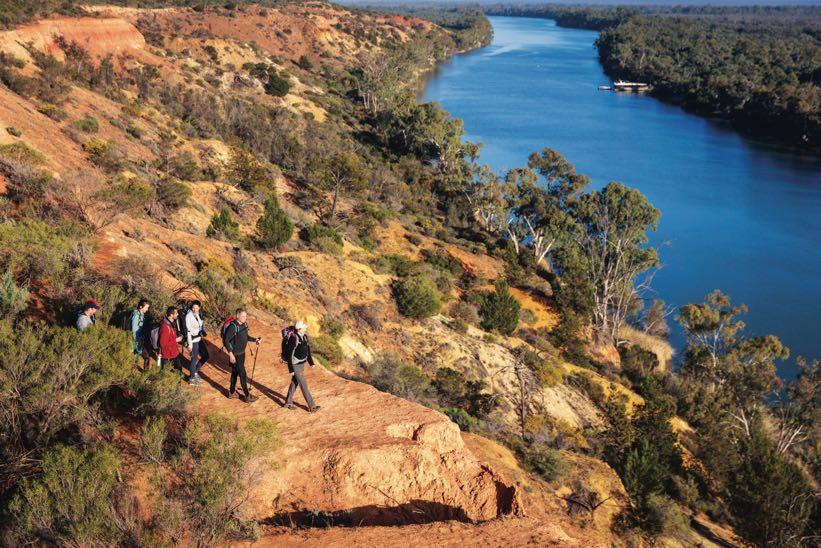
Paddle steamers were an important connection with early European settlement and development – towing large barges, paddle steamers weaved the winding course of the MurrayDarling system, supplying stations and towns with supplies, and carrying passengers and various goods to market, including mail, wheat, fruit, salt, wood, wool and other livestock products.
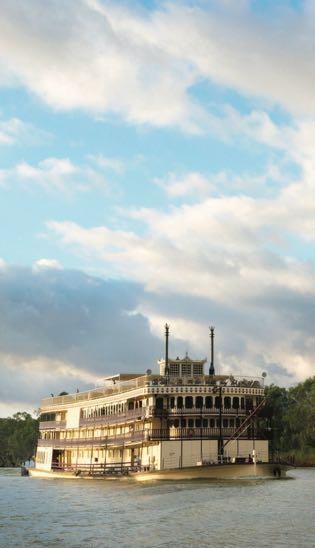
61 www.winenzmagazine.co.nz
Murray River Trails, Riverland.
Captain Cook Cruises PS Murray Princess
MaryAnn Reserve, Mannum, Murray River.
Camels Trains were used to transport salt from the Sunset Country (South-West of Mildura) to the Murray River along wellworn tracks 100 years ago. Led by Afghan team masters, the camel trains could persist in the sandy terrain where it was difficult for oxen, horses and other forms of transportation. The camel teams carried cargoes of wool and other heavy loads including salt from Spectacle Lakes in the Sunset Country, to the Murray River, where the salt was loaded onto paddle steamers, then returned with precious fresh water and supplies.
BAROSSA VALLEY. Home of shiraz wine.
As we walked around Barossa and did the meet and greet with winemakers, and some owners, we felt a timelessness and permanency as if life existed here for ever and you are in the midst of one of the world's foremost wine areas. Among many vineyards we visited one that stood out for us was Peter Lehmann Winery. Phil, is the son of the now late Peter Lehmann. Winemaking wasn’t Phil’s first choice, despite growing up in the Barossa Valley, with a larger-thanlife winemaking father. The hard times of the 1980s, where vineyards were removed, and growers were forced to find other work, were deeply etched in his mind.
Lehmann deeply values relationships and is the first to acknowledge the tutelage he has received along the way from industry greats such as Brian Walsh, Louisa Rose, John Vickery and Robert O’Callaghan. He states with humility, “I have been fortunate to stand on the shoulders of giants.” Although he no longer owns a property, this early experience on the land proved invaluable. Today Lehmann is the senior winemaker for WD Wines, making wines under the labels of St John’s Road, Hesketh, Vickery and Parker Estate. With co-winemakers Charlie Ormsby and James Lienert.
His depth of knowledge across all areas of the industry has no doubt been the key to his success. One can only dream what his future will hold.
Phil Lehmann from Barossa will readily admit to his tearaway side, describing himself as “half cultured winemaker, half motorbike bogan.”
Barossa, with a rich vine and wine history dating back to 1842, Australian wine is inextricably linked with Barossa Shiraz for many people and while the variety is definitely the Barossa’s star performer, varieties like Grenache, Mourvèdre/Mataro, Riesling and Semillon all have a long and distinguished history of producing exceptional wines.
The Barossa Valley was a viticulture and agriculture area settled by the British, but it wasn't long before Silesian Lutheran emigrants from Prussia gave the region a distinctly German flavour. The Silesian Lutherans were escaping religious persecution in their homeland so perfectly fitted Angas' need for hard working people.
But the Barossa Valley didn't build its reputation entirely off the back of hard-working Silesian migrants. Samuel Smith was a brewer at Wareham in Dorset, England. He sailed to Australia in 1847 with his wife and five
children. Upon arriving they heading to the Barossa to get work with George Angas. As Samuel was working as a gardener in George's garden and orchard, he quickly realised that the soil and the climate in the Barossa Valley were perfectly suited to vines. So, he promptly bought 30 acres of land from George and planted the first Yalumba vineyard in 1849. From little things, big things grow...
We loved McLaren Vale, it’s a charming and substantial township surrounded by more than 100 vineyards and wineries. On every side there are fields of grapes and the signposts at various points are thick with invitations to visit cellar doors to sample the vintages and purchase the locally made wines. The McLaren Vale Heritage Trail points out the many distractions along the way; restaurants and eateries to tempt your taste buds with fine foods and local produce; and a number of craft shops, galleries and other points of interest to keep you occupied.
McLaren Vale is located 40 km south of Adelaide.
McLaren Vale's extensive natural and cultural heritage spans over
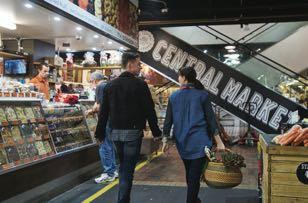
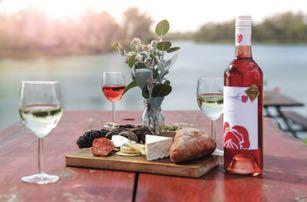

62 | Spring 2023
TRAVEL
North Terrace, Adelaide.
Caudo Wines, Riverland.
Adelaide Central Market.
thousands of years of traditional ownership by the Kaurna people and recently, has been shaped by European colonisation. The colony of South Australia was founded in 1836 and McLaren Vale was established two years after following a survey conducted by John McLaren.
John Reynell and Thomas Hardy planted grape vines in 1838 and the Seaview and Hardy wineries were in operation as early as 1850.
Between 1920 and 1930, many Italian migrants settled in McLaren Vale and introduced olive and olive oil production. More recently, the production of almonds, cheese, milk and cream have added to the rich food tapestry of our region, but it was not until the 1970s that table wine grew in popularity and within the same decade, over 25 new wineries were established in our region which specialised in the production of distinctive Shiraz, Cabernet and Grenache.
Today, McLaren Vale is host to more than 190 producers, including 80 cellar doors. Our region's wines and their makers continue to receive awards and major trophies at the world's most prestigious wine shows.
We headed for the hills.
ADELAIDE HILLS. On leaving Mannum, and on to Adelaide, what
The rolling hills go on forever in the South Australia wine regions.

impressed us most was the very well-maintained highways and Motor Way system making our journey stressless, a breeze actually! Lots of sign post but G.P.S helps of course!
Along with amazing beginnings of the area of Adelaide Hills, is also the beginnings of an exclusive winery Penfolds.
Penfolds Grange is arguably Australia's most famous wine and the story of its creation in 1844, by legendary winemaker Max Schubert with the help of brilliant research chemist Ray Beckwith is a modern tale of imagination, a battle against the odds and redemption.
Penfolds is an Australian wine producer that was founded in Adelaide in 1844 by Christopher Rawson Penfold, an English physician who emigrated to Australia, and his wife Mary Penfold. It is one of Australia's oldest wineries, and is currently part of Treasury Wine Estates.
Christopher and Mary Penfold arrived in Australia from Angmering, West Sussex, UK, at the respective ages of 33 and 24, in June 1844. Following their arrival, they were supported by family members in the attainment of the
500 acres (200 ha) Magill (originally "Mackgill") Estate at the foot of the Mount Lofty Ranges. As part of the cultivation of the land surrounding the cottage that the couple built (named "The Grange.
By 1903 Penfolds was the largest winery in the Adelaide region, with a production total of 450,000 liters (120,000 US gal) of wine. Between 1904 and 1912, more vineyards in McLaren Vale and New South Wales were purchased.
Since then, Penfolds operates two wineries: Magill Estate, at the base of Adelaide's eastern foothills and Nuriootpa in the Barossa Valley.
The mid to late 1800s Adelaide Hills saw the gold rush arrive and with it thousands of new settlers hoping to find their fortune.
By the late 19th century, many of Adelaide’s wealthy residents started to build grand summer houses in the Hills as a cool retreat from the city’s hot summers.
After all our tripping around, meeting friendly locals along the way and sharing a drink or two, it was time for us to say ‘cheers mate’ to this amazing area of South Australia. We’ll definitely be back as we have a lot to see and do yet.
63 www.winenzmagazine.co.nz
Wine Tasting in the Adelaide Hills, South Australia.
Max & Me
From winemakers
Sarah Lehmann, and Phil Lehmann, son of Peter Lehmann.
MAX & ME is the brand of Phil and Sarah Lehmann, born from a chance meeting between Sarah, a ballet dancer, and Max, Phil’s dog, during a 2003 performance in the Barossa. Phil met Sarah shortly after. The encounter was fortuitous and the trio were soon inseparable. Phil & Sarah’s creative philosophies coincided in the intervening years, and now produce small batch wines and olive oil, with a terroir-based philosophy centred on their beautiful Eden Valley Property, Boongarrie Estate...
On suitable sites within the property, 25 acres is planted to vineyard (half Shiraz and half Cabernet Sauvignon est. 1998), and a 10-acre Olive grove planted to Manzanilla Cacereña, Penduleno and Kalamata (Est 2004).
Their philosophy for managing the land is to look after the soils and use minimal chemical inputs; biodiversity in midrow grass and weed populations is encouraged and pest and disease pressures are minimal. Sheep and cattle graze the vineyard grasses during winter, and European species of dung-beetles have been introduced to recycle the animal manure as fertiliser, improving the fertility, water retention and structure. -
Max & Me
Balancing life in small batches
By Heidi Helbig
While the son of Peter Lehmann might walk in the footsteps of giants, he is the architect of his own story, making his mark with Max & Me Wines and leading a life of simple pleasures, seasonality and generosity.
PHIL is most at home with wife, Sarah on their stunningly beautiful piece of Barossa farmland, where they make small batch wines, olive oil and sourdough, and watch the seasons change with children, Lewis and Olive.
However, the journey has been anything but scripted for Phil, who admits he “fought” the pedigree and the winemaking path laid before him.
He eschewed an oenology degree in favour of electrical engineering, before wanderlust took him across the world in his 20s.
It included sojourns in the Napa Valley with Michael Scholz and in Stellenbosch with Ben Radford, before Phil landed in Burgundy for a cultural immersion that was life-changing.
“Because of dad, there was such a big shadow; he was such a figure in the Barossa, I did feel the weight of it,” Phil says.
“But it all sort of crystallised in Burgundy. They’ve been growing grapes for hundreds of years; it’s a job with seasons and loads of reflection time. It’s good, clean work.
“It’s all about the vineyard in France. Take making Clos Vougeot; about 80 different owners each have a few rows and they sell the wine as a Clos Vougeot, not as a winemaker.”
Phil and Sarah reflect this philosophy in their own 25-acre vineyard, describing themselves as “farmers” and applying a light touch with minimal intervention that is closely aligned to biodynamic in terms of biodiversity and soil health.
“The Barossa in the ‘70s and ‘80s was all about the winemaker rockstar who could turn anyone’s grapes into a super red,” Phil says.
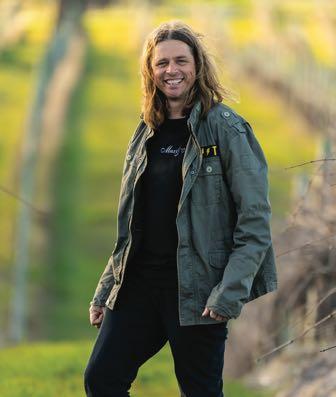
“As time goes by it’s become a celebration of where it’s grown. More and more I try and get out of the way, be less heavy-handed.
“When you let what happens naturally in the vineyard happen, the wines have so much more depth and complexity.”
64 | Spring 2023
TRAVEL
Phil Lehmann.
Phil also owes much to Kym Teusner, for encouraging his sense of experimentation at a crucial time in his career. After emerging from stints at Yalumba and the Lehmann family winery – by then owned by the Hess Group – Phil was at something of a crossroads.

“Kym Teusner bought me a beer one day and said ‘Lehmo, why don’t you come and be my winemaker’,” says Phil.
“It was loose, somewhere between genius and crazy.
“To take a history and artsy approach to winemaking when I wanted to apply science and logical progression, it really changed the way I made wine.
“I developed a love of small batches and became less inclined to tweak things. Rather than making each year look a bit like the previous year, I let it tell its story I suppose.”
Today, that story is reflected in a range of boutique wine styles that are estate-grown and available in the Eden Valley Hotel and selected local restaurants and bottle shops.
Phil, who finally did study oenology, says the signature Riesling is “full flavoured” and
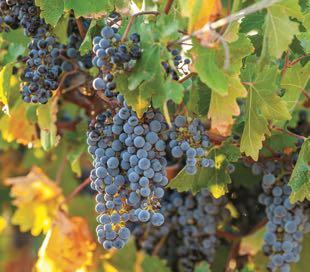
pays tribute to the stewardship of John Vickery, a great friend of his father’s.
Conversely, Sarah describes their Max & Me Shiraz as “fragrant and pretty”, largely due to the higher altitudes and thinner soils of eastern Eden Valley.
“Our Shiraz is our real hero. It smells beautiful – it’s really perfumed,” says Phil. “Where there’s dark plums and cherries on the Valley floor, it’s more mulberries and musk up here.”
“Dad was a really normal bloke. He treated people nice and I use that as a life lesson,” Phil says.
“He was equally comfortable around the farmers as the bookmakers – it wasn’t unusual to come in and find growers or a gang of Chilean pruners around the table having a glass of wine.”
But perhaps Peter is best remembered by those who loved him as a larrikin.
“He had a way of dropping clangers that didn’t cause offence – it was total ratbaggery. He would choose all the wrong words on purpose,” says Phil. “And then you’d see those blue eyes sparkling!” adds Sarah.
WINEMAKING IS IT ART OR SCIENCE
IT’S absolutely both. The science teaches and tells you of the process, gives you the boundaries and informs you of how and why things happen. It’s important, you need to know what the processes are, to give clues where you can tweak around the edges.
The Art is the everything else.
You give 10 winemakers half a ton of the same grapes from the same vineyard, and you’ll get 10 wines, all different interpretations of the fruit.
65 www.winenzmagazine.co.nz
Phil Lehmann.
Great wines begin in the dirt
By Heidi Helbig
Rob Gibson has spent a lifetime digging deep to unearth the secrets to the barossa’s most desirable wine styles.
THE original self-styled Dirtman, Rob ‘Gibbo’ Gibson has always been fascinated by what lies beneath the earth.
As a blow-in to the Barossa in the mid ‘70s, he was a pioneer of the scientific theory that great wines are grown in the vineyard, not made in the winery.
“Wine growing – it’s the bridge between growing flavours in the vineyard and inquisitively watching to see how they turn out,” explains Gibbo.
It’s an obsession that would have Gibbo travelling far and wide in search of flavours to make Australia’s flagship wine, Penfold’s Grange.

He recalls his rise from obscurity at Penfold’s to become a student of science at Roseworthy College under the mentorship of Dr Richard Smart.
“I was working in the lab when Max Schubert and (production manager) Mike Press came to me and said ‘how would you like to work for bugger all for three years and we’ll send you to Roseworthy College’,” Gibbo recalls.
“My degree was oenology, but viticulture – growing flavoursome grapes – was emerging as a specialty science. It was an exciting new stage in the industry.
“When I emerged out of Roseworthy, viticulture was new, so the viticulturists were Dirtmen and the winemakers were Plonkies!”
In a precursor of what was to come, Gibbo fortuitously found himself in the right place at the right time.
“I had an extraordinary opportunity when I went back to Penfold’s – to understand what made Grange Hermitage Shiraz and then to go and find it for the
company from grower-supplied material,” says Gibbo.
“I had a team of bright young graduates who understood the association between what you create in the vineyard and winemaking flavours and characteristics.
“It was a wonderful project, because it sent me to South Africa, Germany, France, the US and all around the world.”
The era also marked the introduction of quality discrimination for Barossa grape growers, another watershed for the industry.
“For us to pay differential prices, that is, to pay for low yield and high quality, we had to come up with an agronomic system that stood up economically,” Gibbo says.
“That was the beginning of quality grading for growers.
“Barossa Shiraz was $265 per tonne but with the differential we introduced, it had a potential for $800 a tonne in one year… pretty soon it went to $3,500 per tonne.
“At the time growers were desperate because of low yields and poor economics, and they were saved in a lot of ways.”
Gibbo describes Penfold’s at that time as the “playground” of the Australian wine industry, as it aggressively pursued the acquisition of some of the nation’s largest and best-known wine companies, including Kaiser Stuhl, Wynns, Tollana and Lindemans.
When the sun finally set on a 20-year career with the corporate giant, the parting was akin to “a broken marriage”, but Gibbo says the time was right for change.
“I got a bit sick of the egos and corporates, and really wanted to see the viticulture side of the business given more management,” he says.
66 | Spring 2023
TRAVEL
“I was driven by a confidence that I knew something special (about winegrowing) and I really wanted to show what I could do.”
His other regret was failing to make an impression on the legendary Max Schubert.
“He always got my name wrong,” laughs Gibbo. “There was a Richard Gibson at the company – no relation – so Max either ignored me or called me Richard!”
Looking to make his next strategic move, Gibbo launched a wine growing consultancy and purchased a small holding at Light Pass with wife, Anne in 1990.
It would become the home of the family business, Gibson Wines, now celebrating its 25th year of winemaking.
“I was driven by a confidence that I knew something special (about winegrowing) and I really wanted to show what I could do.”
Rob attributes its success to “a
lot of help and patience, especially from the family.”
Like the man himself, Gibsons is committed to honest, authentic and “fiercely local” wines that reflect Barossa terroir.
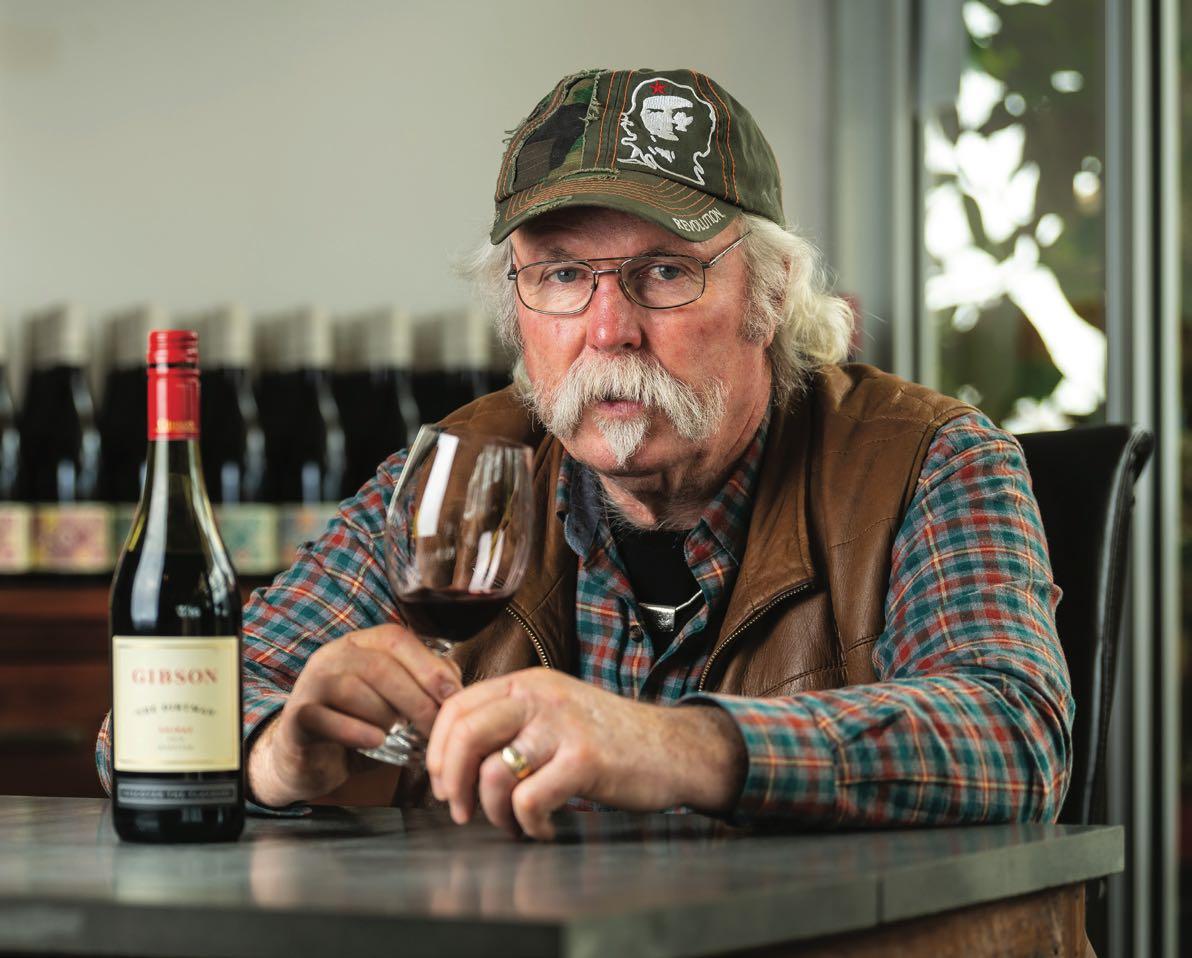
“I was driven by a confidence that I knew something special (about winegrowing) and I really wanted to show what I could do,” Gibbo says.
“We started with 167 cases of Merlot in 1996 and basically doubled our production every year from there.”
While the signature Dirtman Barossa Shiraz accounts for over half of production, Gibbo remains devoted to innovating.
His foray into Mediterranean wine styles is both strategic and experimental, in the belief they can
“stand up” against increasingly dry conditions.
“The Discovery Road label is all about discovering new varieties, Fiano, Nero D’Avola and Montepulciano,” says Gibbo.
“Stylistically, I anticipate these will be great Shiraz blenders and help mitigate the impact of climate change on Barossa wine styles.”
Whatever his legacy, ultimately Gibbo hopes he won’t be remembered as a conformist.
“I’m pretty typical of winemaking types, just being adventurous with flavours. I can’t be pleased, I’m always looking for something better,” he says.
“I was once accused of being self-styled – it was intended as an insult, but I took it as a real compliment!
67 www.winenzmagazine.co.nz
Rob 'Gibbo' Gibson of Gibson Wines.
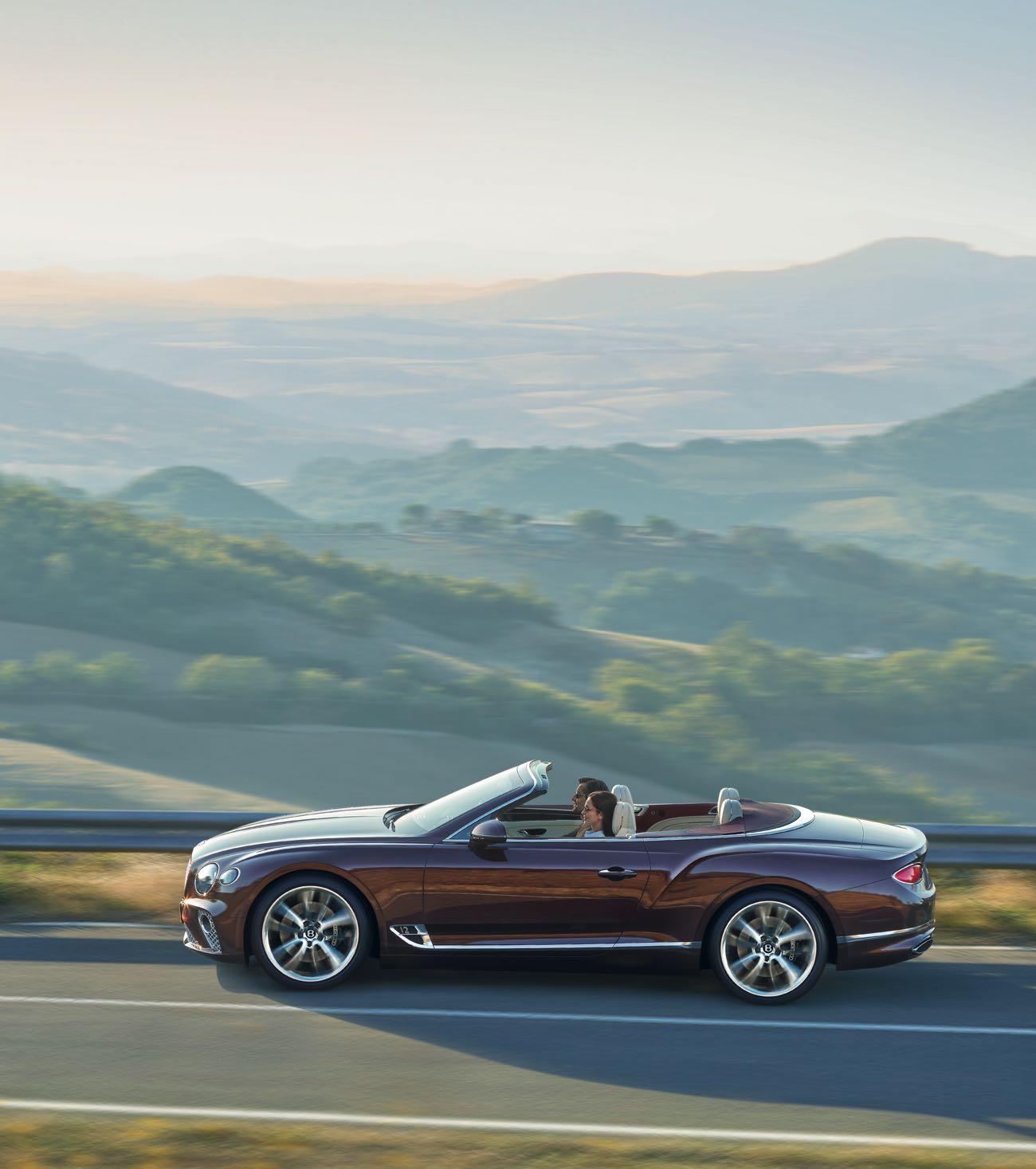

The new Continental GT Convertible. From the definitive grand tourer, the world’s finest convertible is born. From $395,000 + options, discover more at bentleyauckland.com or call (09) 975 8070. Visit us at 119 Great North Road, Grey Lynn. Continental GT Convertible: fuel consumption, mpg (l/100km) – Urban 13.0 (21.7); Extra Urban 28.5 (9.9); Combined 19.8 (14.3). CO2 Emissions 333 g/km. The name ‘Bentley’ and the ‘B’ in wings device are registered trademarks. © 2018 Bentley Motors Limited. Model shown: Continental GT Convertible. MAG17698









































































































































 - Bob Campbell
- Bob Campbell











































